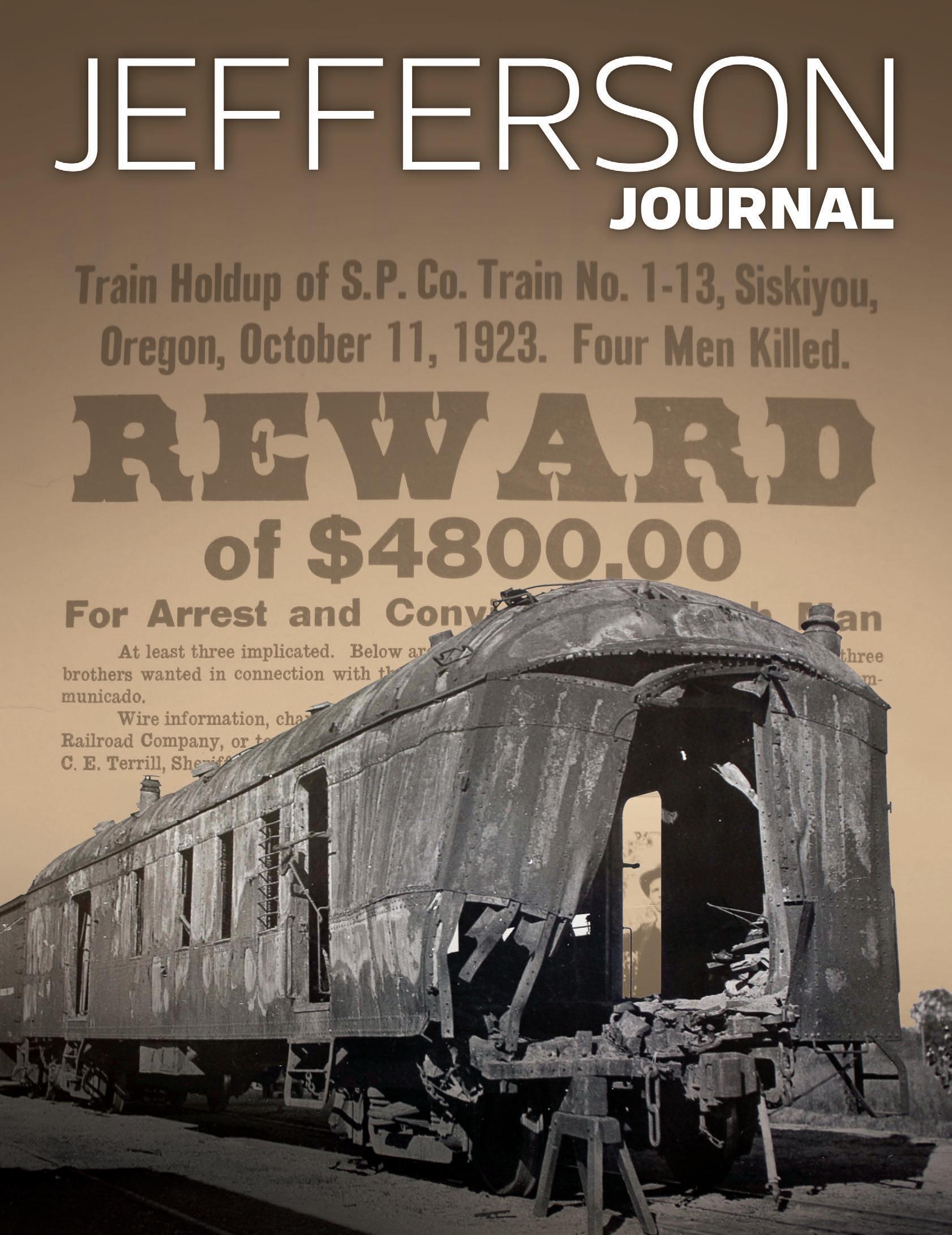
The Members’ Magazine of Jefferson Public Radio September/October 2023 How Forensic Science Helped Solve America’s Last Great Train Robbery Tunnel 13
50 hours . 50 smiles . 50 thousand .
[ THANK YOU FOR 50 YEARS OF GIVING ]
We all give in different ways. Whether you give of your time, skills, pocketbook or otherwise, we thank you for your generosity. As your community foundation, we count on generous people like you to help us improve the lives of all Oregonians. So in this, our 50th year, OCF is celebrating YOU. Thank you. Visit oregoncf.org/50 to see the positive impact we’ve made together, find new ways to give and get inspired.

OREGONIANS HELPING OREGONIANS SINCE 1973 OCF 5O
JPR Foundation
Officers
Ken Silverman – Ashland
President
Liz Shelby – Vice President
Cynthia Harelson –
Medford/Grants Pass
Treasurer
Andrea Pedley – Eureka
Secretary
Ex-Officio
Rick Bailey
President, SOU
Paul Westhelle
Executive Director, JPR

Directors
Eric Monroe – Medford
Ron Meztger – Coos Bay
Rosalind Sumner – Yreka
Dan Mullin – Eugene
Karen Doolen – Medford
JPR Staff
Paul Westhelle
Executive Director
Darin Ransom
Director of Engineering
Sue Jaffe
Membership Coordinator
Valerie Ing
Northern California Program Coordinator/Announcer
Abigail Kraft
Business Support Manager/ Jefferson Journal Editor
Don Matthews
Classical Music Director/ Announcer
Geoffrey Riley
Assistant Producer/ Jefferson Exchange Host
Colleen Pyke
Announcer
Erik Neumann
News Director/Regional Reporter
Dave Jackson
Music Director/Open Air Host
Danielle Kelly
Open Air Host
Soleil Mycko
Business Manager
Angela Decker
All Things Considered Host
Jefferson Exchange Senior Producer
Charlie Zimmerman
JPR News Production Assistant
Zack Biegel
JPR News Production Assistant
Calena Reeves
Audience & Business Services Coordinator
Liam Bull
Audience Services Assistant
Vanessa Finney
Morning Edition Host
Roman Battaglia
Regional Reporter
Jane Vaughan Regional Reporter
Ella Hutcherson
Snowden Intern
Josh Raines
Network Engineer
Noah Brann-Linsday
Crystal Rogers
6 Tunnel 13: How Forensic Science Helped Solve America’s Last Great Train Robbery
By Pepper Trail and Edgard Espinoza
On October 11, 1923, the Southern Pacific train #13, called the Oregon–California Express, was slowly laboring up the Siskiyou grade, on its way to San Francisco. Normal safety procedures called for slowing the train at the top of the Siskiyou Pass to test its brakes before the steep descent into California. At that moment three men climbed aboard just as the train entered Tunnel 13. These men were later determined to be the three deranged DeAutremont brothers: twins Roy and Ray, and their younger brother Hugh.
13 Rafting Outfitters Prepare For Change On The Klamath River
By Juliet Grable and Erik Neumann
Rafting the Upper Klamath River is possible through the summer thanks to releases of water from the J.C. Boyle Dam, which will be removed next year. When guides return to the Upper Klamath in 2025, this stretch of the river will be forever changed.
Jack Barthell
Derral Campbell
Craig Faulkner
Ed Hyde
Alan Journet
Autumn Micketti
Peter Pace
Krystin Phelps
Frances Oyung
Laurell Reynolds
Raymond Scully
Shanna Simmons
Lars Svendsgaard
Traci Svendsgaard
Robin Terranova
JEFFERSON JOURNAL (ISSN 1079-2015), September/
October 2023, volume 47 number 5. Published bi-monthly (six times a year) by JPR Foundation, Inc., 1250 Siskiyou Blvd., Ashland, OR 97520. Periodical postage paid at Ashland, OR and additional mailing offices.
POSTMASTER: Please send address changes to
The Jefferson Journal, 1250 Siskiyou Blvd.
Ashland, OR. 97520
Jefferson Journal Credits:
Editor: Abigail Kraft
Managing Editor: Paul Westhelle
Poetry Editor: Amy Miller
Design/Production: Impact Publications
Printing: Oregon Web Press
FEATURED
Jefferson Public Radio is a community service of Southern Oregon University.
JPR Foundation is a non-profit organization that supports JPR’s public service mission. Jefferson Public Radio welcomes your comments: 1250 Siskiyou Blvd., Ashland, OR 97520-5025 | 541-552-6301 | 1-800-782-6191 530-243-8000 (Shasta County) | www.ijpr.org jprinfo@sou.edu
The
Jacqui Aubert
Programming Volunteers JEFFERSON JOURNAL September/October 2023 5 Tuned In | Paul Westhelle 19 Press Pass | Erik Neumann 21 JPR News Focus: Music, Arts & Culture | Ella Hutcherson 23 JPR News Focus: Environment, Energy and Transportation | Erik Neumann 24 JPR Radio Stations & Programs 27 Inside The Box | Scott Dewing 29 JPR News Focus: Environment | Erik Neumann 33 JPR News Focus: Law & Justice | Lauren Dake 36 JPR News Focus: Health & Medicine | Marisa Kendall 38 Underground History | Chelsea Rose 40 Down To Earth | Grant Stringer 43 Recordings | Dave Jackson 45 Milk Street | Christopher Kimball 46 Poetry | Eric Tran
They say it takes a village to raise a child...
Together, with you, we're the village it takes.
Relief Nurseries partner with parents to give them the support, tools, and information they need to be the best parents they can be. Together, we can give Oregon's children the best start possible.
LEARN MORE AT OregonReliefNurseries.org

Federal Funding For Public Broadcasting … What’s Next?
It’s budget season in Washington, D.C. and that usually means some amount of drama. While the season is still relatively young, already the House Appropriations Committee may soon consider a draft bill that would call for the elimination of all federal funding for public broadcasting. We’ve been down this road before, and it’s worth remembering how federal funding for public radio and television works in the U.S.:
• During the past fiscal year, federal support for both public radio and television totaled $465 million, an amount equal to $1.40 per American.
• Funding is allocated in the budget process via appropriation bills approved by both the House and Senate and signed by the President. Funding for public broadcasting is contained in separate House and Senate Labor, Health/Human Services and Education appropriation bills.
• Approved funding is distributed through the Corporation for Public Broadcasting (CPB), a nonprofit organization that was established as part of The Public Broadcasting Act of 1967 to facilitate the growth and development of public broadcasting to provide instructional, educational, and cultural programming.
• By statute, more than 70% of CPB’s annual federal appropriation goes directly to approximately 1,500 local public media stations to provide operational support. CPB administers annual community service grants, evaluates station effectiveness and ensures accountability to Congress and the President. CPB’s administrative overhead is very low at less than 5% of federal funding.
• 251 of the total 549 CPB grantees are considered rural, based on population density. In recent years, CPB has shifted its strategic direction to prioritize distributing more resources to rural stations. Rural stations depend more on CPB funding than urban stations and face some very specific challenges, such as smaller and less wealthy donor populations and higher engineering and broadcasting costs that result from operating multiple transmitters and translators in order to reach relatively small communities in more remote areas.
• Federal support for public broadcasting is designed to provide core funding for locally-governed public media stations and be a catalyst for private philanthropic support. Each year, over $8 is raised in private contributions for every $1 of federal support.
During the past fiscal year, JPR’s annual grant from CPB amounted to approximately 13% of our operating budget. Without this stable funding source, it would be very difficult for us to sustain the level of service we currently provide.
We encourage you to share your views about continuing federal support for JPR and other public radio and television stations around the country. Here’s how:
• Register for updates at the Protect My Public Media website at protectmypublicmedia.org. When hearings are held or further developments take place you’ll be informed via email and will be in a position to call or write your elected officials at critical times in the budget process.
• Use social media to share a powerful story or an inspired piece of music you’ve heard on JPR – also share the protectmypublicmedia.org website.
• Make a personal contribution and urge others to support JPR and the public radio and TV stations you listen to and watch—local support remains crucial as we plan our service during uncertain times. It’s easy to donate at ijpr.org.
Thank you for your loyal and generous support of JPR’s mission. Our commitment to creating a more informed public through fact-based journalism and fostering the discovery and preservation of music has never been stronger.
Paul Westhelle is JPR’s Executive Director.

SEPTEMBER/OCTOBER JEFFERSON JOURNAL | 5
During the past fiscal year, federal support for both public radio and television totaled $465 million, an amount equal to $1.40 per American.
TUNED IN
PAUL WESTHELLE
Tunnel 13

How Forensic Science Helped Solve
America’s Last Great Train Robbery
by Pepper Trail and Edgard Espinoza
Every fall, the maples and dogwoods color the foothills of southern Oregon with yellow and orange highlights, flaring vibrant among the dark green pines. Through these Siskiyou Mountains, the railroad line once known as the “Road of a Thousand Wonders” snakes its way toward California, crossing moss-covered ravines on rickety trestles and piercing the mountain ridges with long dark tunnels. This segment of the Southern Pacific railroad line is all but abandoned today, and walking among the decaying railroad ties and rusting steel tracks, it is hard to imagine that exploding dynamite once filled the air with black smoke, and bloody bodies were left to die on these tracks. But on a distant October morning in 1923, this was the site of the West’s last great train robbery, committed by three deranged criminals: the DeAutremont brothers.
This cowardly and murderous event outraged America, leading to an intense manhunt. The crime itself is a story that has been told many times, but much less has been written about the pioneering use of forensic science in the investigation that followed. Few people realize that the remote mountain wilderness of southern Oregon was the location of many law enforcement firsts in the United States.
THE CRIME
On October 11, 1923, the Southern Pacific train #13, called the Oregon–California Express, was slowly laboring up the Siskiyou grade, on its way to San Francisco. Normal safety procedures called for slowing the train at the top of the Siskiyou Pass to test its brakes before the steep descent into California. At that moment three men, who had been hiding next to the then well-known Dollarhide toll road, climbed aboard just as the train entered Tunnel 13. These men were later determined to be the three DeAutremont brothers: twins Roy and Ray, and their younger brother Hugh.
Once on board, the DeAutremonts leveled their sawed-off shotguns at engineer Sydney Bates, and forced him to stop the train inside the tunnel. They focused their attention on the mail car, which they apparently believed was carrying cash or other valuables. Seeing the armed robbers approaching, Postal Clerk Elvyn Daugherty locked himself in the secure mail car. However, this quick action was not enough to save the young clerk. The DeAutremonts had come prepared with a large charge of dynamite, which they attached to the door of the mail car and detonated, blowing Elvyn Daugherty to pieces. A brakeman named Charles Orin Johnson who emerged into the smoked-filled tunnel to investigate the cause of the explosions was gunned down and killed. The DeAutremonts then ordered engineer Sydney Bates to move the engine forward and fireman Marvin Seng to uncouple the mail car. However, their dynamite explosion had caused such damage that the railroad cars couldn’t be separated, and the mail car was so filled with smoke that they couldn’t
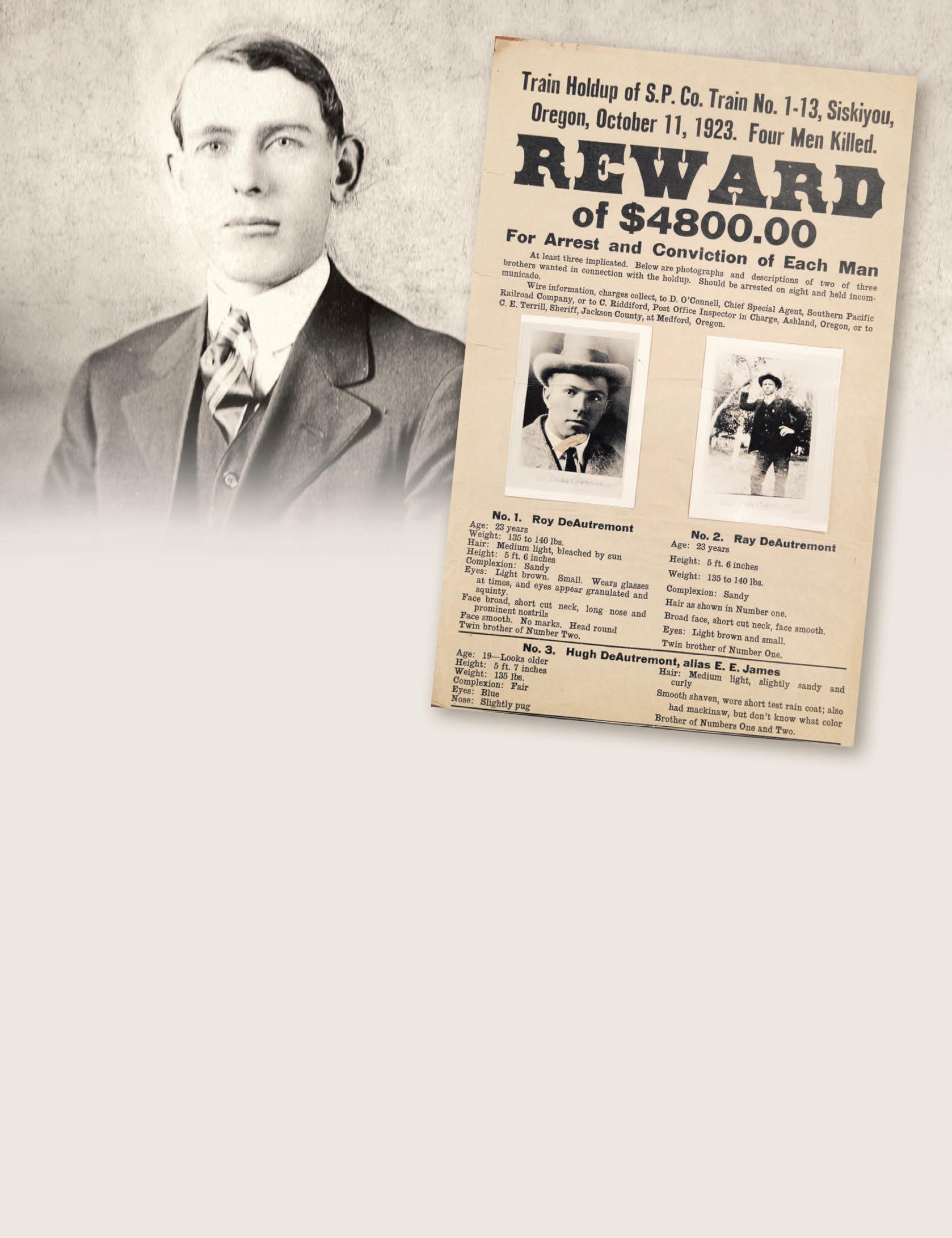 The U.S. government eventually issued 2,265,000 wanted posters printed in English and five other languages which were then distributed internationally. previous page: Tunnel 13, Ashland, Oregon—site of the last “great” train robbery in the west.
The blast set by the DeAutremont brothers ripped open the mail car, killing mail clerk Elvyn Daugherty of Ashland.
The U.S. government eventually issued 2,265,000 wanted posters printed in English and five other languages which were then distributed internationally. previous page: Tunnel 13, Ashland, Oregon—site of the last “great” train robbery in the west.
The blast set by the DeAutremont brothers ripped open the mail car, killing mail clerk Elvyn Daugherty of Ashland.
find the money they had planned to steal. Faced with the complete failure of their robbery, and determined to leave no witnesses, the DeAutremont brothers murdered engineer Sydney Bates and fireman Marvin Seng in cold blood, shooting them as they held their hands in the air (the coroner later determined that the bullets went through the raised arms of the victims before striking their temples). The DeAutremonts then fled, leaving death, destruction, widows and fatherless children behind.
THE CRIME SCENE AND THE EVIDENCE
Crime scene investigations in 1923 were based on good old-fashioned logic by street-smart law enforcement officers. As soon as responding personnel realized that engineer Sydney Bates and fireman Marvin Seng had been shot, posses formed to look for the murderers. The largest man hunt ever assembled included Southern Pacific railroad investigators, local citizens, members of the Oregon National Guard, personnel from Sheriff’s office from California and Oregon, and local police officers. All these individuals collected evidence they deemed important. A novel idea was to use airplanes to fly low over the mountains looking for suspects, a law enforcement first.
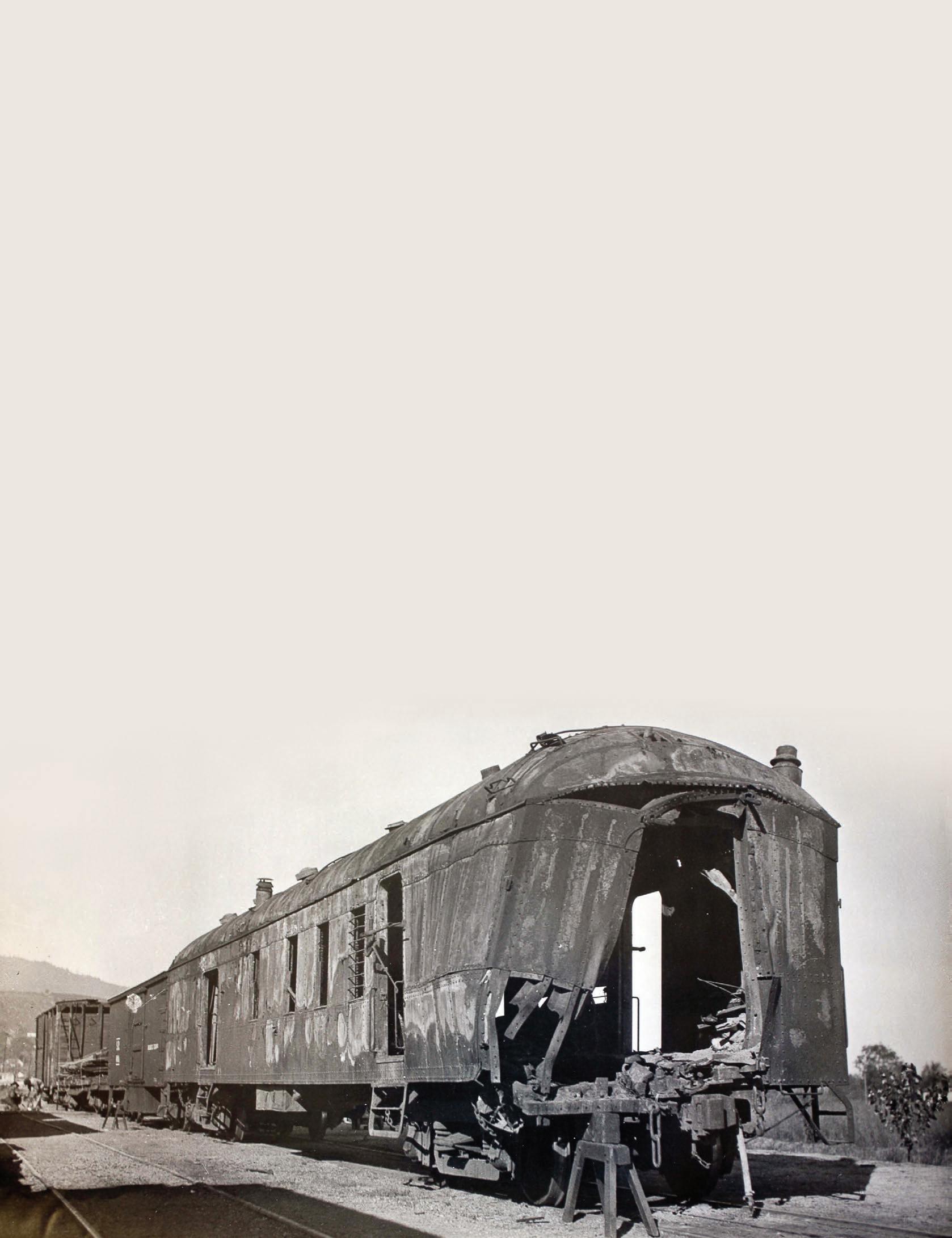
About 2 miles south of Tunnel 13, a cabin was found which showed evidence of recent habitation and was thought to have been used while planning the holdup. This became a second focus of the investigation. Several other campsites
were discovered that appeared to have been used during the escape. Examination of case records in the sheriff’s office of Jackson County, Oregon, reveals the following partial list of the evidence collected from the tunnel:

One colt automatic pistol 45 caliber
One pair of “Pay Day” brand bibbed overalls
Detonating machine
Fuse wire and cap
Several 45 caliber shells
12 gauge shot gun shells
Some of the evidence collected from the cabin and campsites included:
One towel from cabin near tunnel
One union suit from cabin near tunnel
Three brown canvas blanket bags
One scorched coat
One valise
Two cans
Tunnel 13 has cut through Siskiyou Pass since 1887 and is 3107’ long.
Evidence of the magnitude of the explosion set by the DeAutremont brothers in their effort to gain access to the mail coach.
One pair of gloves, leather
One pair socks, from cabin near tunnel
Three pieces of wire and bone from cabin fireplace
Two gun wipers cloth
THE BEGINNING OF FORENSIC SCIENCE IN THE US
Once the evidence had been collected, cataloged and compiled, the State and Federal law enforcement authorities knew precisely how the crime was committed, but had no clues as to who the criminals were. Therefore, they decided to send the evidence to a 42-year-old chemistry professor at the University of California at Berkeley who had had some success in helping Southern Pacific railroads with minor train robberies. His name was Edward Oscar Heinrich.

In the early 1920s, crime labs existed only in Europe. The world-famous FBI crime lab was not founded until 1932. Therefore it must have been a bold move for law enforcement personnel to submit evidence to a university professor in 1923. Professor Heinrich used meticulous scientific processes to examine the evidence and his analyses yielded surprising results. Until recently, the only available information about Professor Heinrich’s conclusions were the sketchy news reports of the day. However, new discoveries in the archives of the Bancroft Library at UC Berkeley — reported here for the first time — give us the first detailed documentation of Heinrich’s pioneering forensic work. For example the results of the analysis of the “One pair of ‘Pay Day’ brand bibbed overalls” reads:

“In the pencil pocket at the left side of the bib watch pocket on the left front bib of the overalls I found a receipt for a registered letter, postmarked “Eugene, Oregon, September 14, 1923 Registered.” This receipt is numbered 2361 and is initialed for the postmaster per “B”.
From a microscopic examination of the dust, hair, and fibers collected from the pockets, chemical analysis
of the stains on the garment, and a study of the set of his garment induced by wear, I am of the opinion that the wearer and owner was a lumber jack employed in a fir or spruce logging camp. I computed him, subject to revision with further data which might be found, to be a white man not over five feet ten inches tall, probably shorter; weight not over 165 pounds, probably less. Age between 21 and 25. When in city clothes he is a careful dresser, neat in appearance, has medium light brown hair, complexion fair; has light brown eyebrows; well developed and small hand and feet.
I found the suspenders of the overalls were handled exclusively from the left side, also the pockets on the left side to be those most frequently used. The left suspender I also found to set ¾ inches higher over the left shoulder that the right.”
From a forensic point of view, these inferences from a pair of overalls are amazing — better than TV scripts for popular CSI shows. The registered receipt that had escaped everyone’s notice was a crumpled piece of paper found deep in the narrow pencil pocket. This receipt focused the investigation on the DeAutremont brothers, ultimately confirming many of the details inferred by Professor Heinrich.
In the analysis associated with the Siskiyou train robbery Professor Heinrich conducted handwriting comparisons, examined latent fingerprints, bullets, cartridges, fibers, hairs, stains, blood, etc., and conducted serial number restoration on the recovered handgun. Thus, he used most of the techniques that are still used today to deduce how and who committed the crime.
Heinrich was able to link a .45 caliber gun found at the crime scene with Ray through serial number restoration. Hair recovered from the “Pay Day” bibbed overalls place Roy at the crime scene and it was established that Hugh was at the planning cabin by analyzing the handwriting on sale receipts for supplies. After the media publicized Heinrich’s deductions, he
SEPTEMBER/OCTOBER JEFFERSON JOURNAL | 9
The case of the Siskiyou train robbery transformed the reserved chemist Edward Oscar Heinrich into a national celebrity.
The DeAutremonts had come prepared with a large charge of dynamite, ultimately using it to blow apart the mail coach, shown here.
was often referred to as the “Wizard of Berkeley” or the “Edison of crime detection”.
The DeAutremont case validated the power of forensic science and crime scene investigation, and in late 1923 Los Angeles established the first police department crime laboratory in the United States. Its director was August Vollmer, a student of Professor Heinrich who had been Chief of the Berkeley Police Department.
POSTSCRIPT
Even with Professor Heinrich’s work, it took four long years for the fugitive DeAutremont brothers to be apprehended. At the time this was the most extensive and expensive manhunt in the U.S. More than 2 million wanted posters of the brothers were ultimately printed in Spanish, French, Portuguese, German and Dutch. All in all, over $500,000 ($6.5 million dollars in today’s economy) was spent in the search for the DeAutremont brothers, who were finally arrested in 1927. The youngest, Hugh DeAutremont had joined the US Army and was stationed in the Philippines. He was recognized by a fellow soldier who saw the DeAutremonts’ wanted posters when he was transferred from the Philippines back to California. Hugh was convicted of first-degree murder by a jury of his peers in the Federal Court house in Jacksonville, Oregon. The two other brothers were also recognized from posters and were arrested in Ohio by FBI agents in June 1927. After their extradition to Oregon, Roy and Ray DeAutremont pled guilty to first degree murder. All three of the DeAutremont brothers were sentenced to life in prison and were transferred to the Oregon state prison in Salem, Oregon.
At the time, there was much controversy that the DeAutremonts had escaped the death penalty, as indicated by the following editorial in the San Francisco News Letter following the verdict:
The Railroad Murders
There has been much dissatisfaction over the fact that the de Autremont brothers should have escaped the death penalty for their crime in the robbery and murders attendant upon their criminal attack on a Southern Pacific train. It was one of the most dastardly and contemptible crimes in recent history and involved the killing of three workingmen, whose deaths were not even necessary to the carrying out of the robbery.
We are of the opinion that the so-called confession of Hugh de Autremont bears on its face a certain unreal swagger and insincerity which should cause it to be regarded with great suspicion…
The question presented by this case is not very easy of solution. For many reasons it would seem better that the crime should have been proved against them by the State, if only for the purpose of showing the criminally inclined that in the long run a crime career is not a paying career. It is very important that this lesson should be impressed upon wavering youth and it does not seem to us that the method taken of ending the de Autremont case was the best method. Somehow the punishment does not seem to fit the crime.
San Francisco News Letter (July–December 1927)
By today’s standards the twin DeAutremont brothers would probably have been diagnosed with mental illness. Roy was diagnosed with schizophrenia in 1949, and given a frontal lobotomy that left him unable to care for himself. He was paroled in 1983, and died soon afterward. Ray was paroled in 1961, after expressing repentance for his crimes. He lived in Eugene until his death in 1983. Hugh had been paroled in 1958 and died of cancer less than a year later.
Legend has it that for decades after the crime, railroad engineers who traveled close to the Oregon State prison blew their horns in contempt for the DeAutremont criminals. Sadly, today we know more about the murderers than of the families of Postal Clerk Elvyn Daugherty, brakeman Charles Orin Johnson, engineer Sydney Bates, and fireman Marvin Seng, who perished at a time when there was only meager compensation for dying on the job.
POST-POSTSCRIPT: UNSOLVED MYSTERIES
In their quest to find the lost original report of Edward Oscar Heinrich, the authors have studied multiple first sources that had not been examined for over 80 years. This research has produced a number of fascinating discoveries.
The timeline at the crime scene indicates that the DeAutremonts had perhaps as much as an hour to search the blown-up mail car, but it is commonly accepted that the murderers got away with nothing. Therefore it was an astonishing surprise to find at the Jackson County Sheriff’s Office witness statements that imply the DeAutremonts had something to hide.
First there is a witness statement by an Ashland resident called L. Zundel who describes two individuals in the company of a suspicious person described as follows:
“…one unknown party was at the summit of the Siskiyou Mountains just opposite the tunnel at the little hotel on the hill on the sixth day of December 1923, 9 am. The lady that runs the hotel states they came up about 5:30 or 6 am, made arrangement for breakfast, and then went some place. On their return they ate breakfast…(they) gave the following description of the small man: age 22 or 23, dark complexion, wore dark cap, blue waiste (sp) overalls, height 5.6, weight about 140 pounds, small features, small dark eyes, wore dark vest coat”
A few hours later on the same morning the above described man called at a little cabin near the foot of the Siskiyou, occupied by a wood cutter, and asked him if he had been in the loft of the cabin recently, and he replied that he had; ask him if he had found any package, stating that he had left some walnuts there the year before, and the wood cutter stated he did not believe there was any there but replied he would look and see. (He) unlocked the cabin and the wood cutter boosted him into the loft. He reached under the two floors and brought out a mackinaw coat which was all rolled up seeming to contain something light, in weight, probably would weigh 30 or 40 pounds, very well done up. He then left with the package toward the highway, north.
The second witness statement comes from the T.B. Gosnell from Ashland and is the wood cutter described above. He states:
10 | JEFFERSON JOURNAL SEPTEMBER/OCTOBER 2023
Twins
and
were 23
old
“I am a wood cutter and have a cabin in the foot of the Siskiyou Mountains, on Wall creek, near tunnel 16 in the Siskiyous. About December 6, 1923, a man about 5 foot 6 inches, perhaps 25 or 30 years of age, small eyes, dark, came to my cabin quite early in the morning got a mackinaw coat from the loft of the cabin. He said this coat contained walnuts that he had left there early the fall. I assisted him into the loft and helped him down with this bundle. It weighed perhaps 20 pounds and it did not appear to me that it contained walnuts. The coat was tied up so as to afford a wrapper for something. As near as I can recall it was a plaid mackinaw coat, dark in color and dirty.
Frank Stullenberger found a mackinaw coat in a creek bank near a stump of a tree about 300 yards from this cabin.
I found a grub hoe, pick and shovel under some brush about a quarter of a mile north of this cabin, and about a hundred yards from the Pacific Highway about March 1924”
The third witness statment comes from Frank Stullenberger from Ashland. His statment is:
About March 10, 1924, I found a red and black checked mackinaw coat … in the bed of a creek about 350 yards from my cabin in the Siskiyou Mountains, near the S.P. Ry. Track. In the pocket of this coat was part of an El Paso, Texas, newspaper, dated February 24, 1924. (El Paso Times). This paper was in a breast pocket, under the overplaing flap of a loggers jacket. … The coat had two or more cuts in it, one in the back, perhaps an inch and a half wide, appeared to have been cut with a sharp knife blade….

There is a little cabin in an out of the way place on the Nellie Russell place which apparently has not been occupied for several years. “DeAutremont Bros.” is written on the back door of this cabin with lead pencil. I saw this in January, 1924.”
Given these statements is it feasible to construct the following scenario: The DeAutremonts may have had logistical support and accomplices (e.g., the small dark man). After the train robbery they escaped with something valuable and hid it in the loft of T.B. Gosnell’s remote cabin. Twenty-five days later the accomplices recovered the loot. The Southern Pacific Railroad, which kept meticulous shipping records, may have had its own reasons for never revealing the nature of their losses in this last great western train robbery.
It is tempting to speculate that the DeAutremonts had help. Otherwise how can one explain their incompetence during the crime but their resourcefulness at avoiding capture in the face of organized searches by so many competent law enforcement agencies? Clearly these speculations cannot be proven since all parties have undoubtedly passed away. But the common portrayal of the DeAutremont brothers as dim-witted and misguided youths who eventually repented of their crimes may be more of a romantic notion than reality.
Perhaps the best epilogue to this story was stated by Frank Stullenberger in 1924:

“I have lived in the woods for about eight years and do not believe walnuts could be left unmolested in any open cabin for any length of time. The rats, squirrels or chip monks would be very apt to carry them away the first night…..It appears to me that some foul play has been commited in that vicinity…”
We are left with unanswerable questions, with the distant imagined echo of that explosion, the gunshots, and the cries of the innocent victims. Even the best detective can never untangle all the mysteries, and the never-ending consequences, of the DeAutremonts’ dark crime on that bright October day so long ago.
ACKNOWLEDGEMENTS
The authors gratefully acknowledge the Sheriff’s Department of Jackson County, Oregon, and the Bancroft Library of the University of California at Berkeley for providing access to historical materials used in researching this article.
Edgard Espinoza is a forensic scientist at the U.S. Fish and Wildlife Forensics Laboratory in Ashland, Oregon. Pepper Trail is a retired forensic ornithologist who also worked at the U.S. Fish and Wildlife Lab.
Underground History Live is back!
And this time we’re serving murder, mayhem, and mystery as we mark the 100th anniversary of Southern Oregon’s Tunnel 13 Train Robbery. Join Jefferson Exchange host Geoffrey Riley and Underground History host Chelsea Rose from SOU’s Anthropology Lab on Wednesday, Oct. 11 from 5–8pm at the Ashland Hills Inn & Suites’ Cosmos Ballroom.
This edition of Underground History Live features a variety of exhibits, a screening of the documentary Murder on the Southern Pacific with Oregon Public Broadcasting’s Kami Horton, and a moderated panel discussion that will include a forensics expert, postal inspector, an historian, and a railroad representative. The event is a deep dive into the story and ongoing mysteries of one of the most notorious crimes in the region and the historical advances in forensic sciences that it sparked.

SEPTEMBER/OCTOBER JEFFERSON JOURNAL | 11
Roy
Ray DeAutremont
years
when they were joined by their younger brother, Hugh, in robbing Southern Pacific’s train #13, called the Oregon Express, in hopes of stealing the cash and valuables they believed were on board that day.

ASHLAND HIGH SCHOOL SOU’S STEVENSON UNION SCIENCEWORKS MUSEUM DRIVING ROUTE Takes approx 5 min BIKE/WALK ROUTE Takes between 7–25 min depending on if biking or walking KEY 237 N. FIRST ST. • (541) 482-2237 WWW.ASHLANDFOOD.COOP @ASHLANDFOODCOOP • SOUTHERN OREGON CERTIFIED ORGANIC RETAILER • Fuel your adventure WITH POWER PACKED NUTRITION!
Rafting Outfitters Prepare For Change On The Klamath River
Rafting the Upper Klamath River is possible through the summer thanks to releases of water from the J.C. Boyle Dam, which will be removed next year. When guides return to the Upper Klamath in 2025, this stretch of the river will be forever changed.
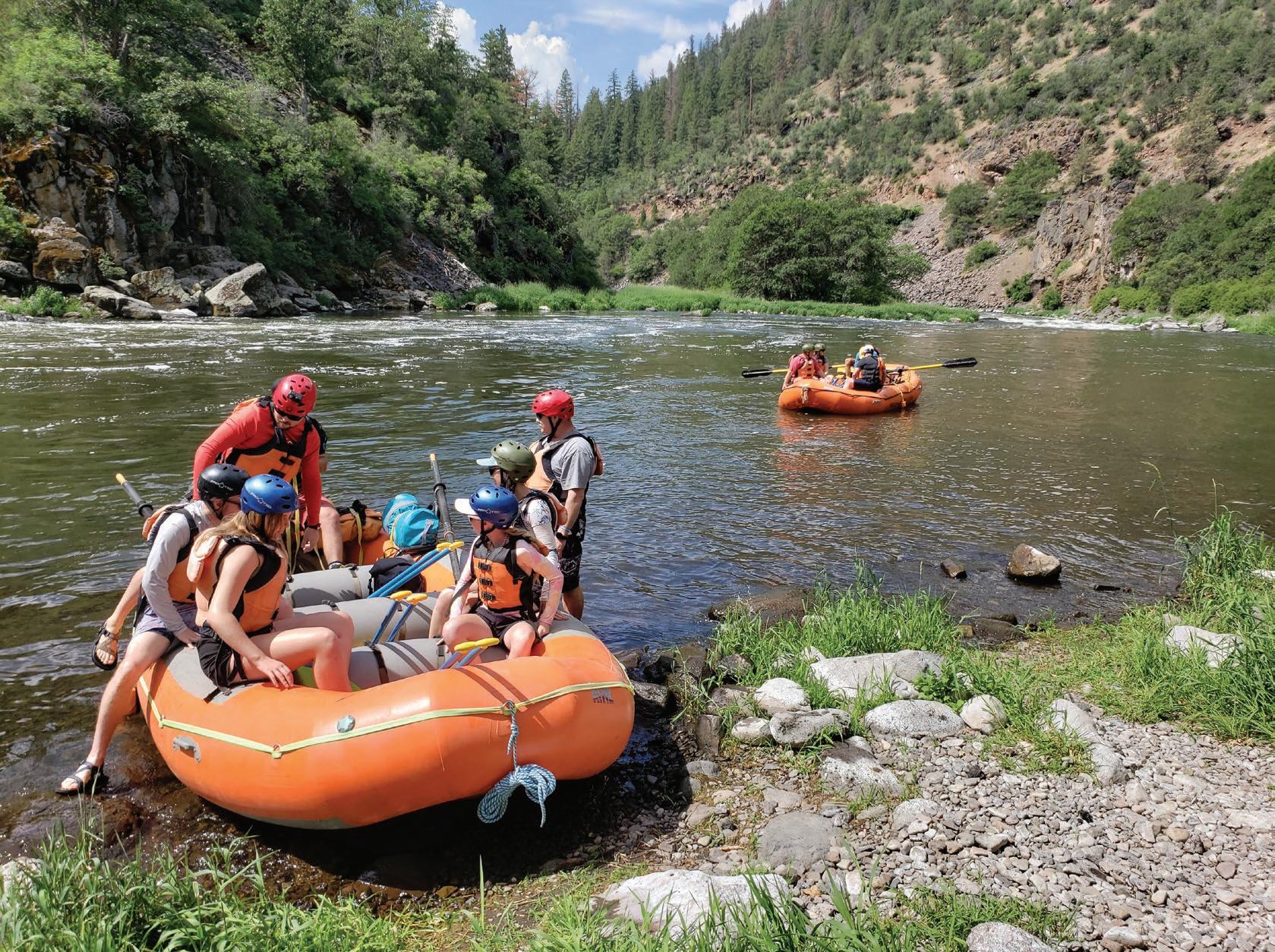 by Juliet Grable and Erik Neumann
by Juliet Grable and Erik Neumann
At Spring Island, a popular put-in spot on the Upper Klamath River, a dozen or so whitewater rafters are getting ready to run a reach called Hell’s Corner Canyon. The thrill seekers adjust helmets and snug their life jackets as Nate McLennan, a rafting guide with Noah’s River Adventures, describes what they’ve signed up for.
“We’ve got two big Class Four-plus rapids: one called Caldera; one called Hell’s Corner,” says McLennan. “They’re going to be long, big, fast: lots of paddling; lots of grabbing on; lots of shifting around in the boat.”
McLennan covers safety next: what to do in case of an involuntary group swim; how not to club fellow passengers in the head with a paddle. While he talks, the other guides load gear and pump the inflatable rafts taut. By 10:00 a.m., trailers from three Rogue Valley rafting companies — Noah’s, Momentum River Expeditions, and Indigo Creek Outfitters — have swarmed the boat ramp.
The boats from Indigo Creek push off first. In one, the guide sits at the stern while his crew of four practices coordinated turns. Then they set off downriver, bumping over frothy riffles and past a jumble of basalt boulders before disappearing around the bend.
Bart Baldwin, who owns Noah’s, calls Hell’s Canyon a “giggle fest.” “The kids love it; the adults love it,” he says. “It’s just one after another after another after another of warm, splashing water.”
Guides like McLennan cut their teeth on the Upper Klamath; the run they’re doing today consists of 14 technical, hardto-read miles and 42 named rapids.
“You know, the Rogue River is where you get a lot of your first paddle strokes,” says McLennan. “And then you come up here. This is where you really dial in all those techniques and skills, learning to run bigger river features.”
Continued on page 15
Rafters from Noah’s River Adventures from Ashland, Ore. depart from Spring Island for a float on the Upper Klamath River in June, 2023.
PHOTO: JULIET GRABLE







C R K C R E E K C R E 6 5 6 7 8 9 7 8 9 0 3 4 25 26 24 23 22 2 20 28 29 30 3 32 33 34 35 36 37 38 39 40 41 42 43 44 45 46 48 47 49 50 5 52 53 54 4 3 2 1 WHEELDON WAY K R K L A N E O L D W L L O W L A N E HAGEN WAY HAGENWAY BEACH CREEK 3,822 sq. ft. N H E S S P R O M E N A D E N. MOUNTAIN AVE. SOLD SOLD SOLD SOLD PENDING BIKEPATH PENDING PENDING PENDING PENDING PENDING PENDING PENDING PENDING PENDING PENDING NEW ENERGY EFFICIENT HOMES FOR SALE Beach creek is a neotraditional neighborhood of 52 smartly Designed view homes focused on e cient living, wise resource use, and a low carbon footprint. For more information or to schedule a tour, please visit www.Kda-homes.com or call us at 541-944-7730. HOMES STARTING IN THE $400’S IN THE HEART OF ASHLAND (541) 944 - 7730 230154 I ride the bus… Getting there together since 1975. “I ride the bus to get to work. My family and I just moved here, and my wife and our kids use the car right now. Having access to the bus has been huge for us.” — Mike
Spring Island is just downstream of the J.C. Boyle Dam and hydropower plant near the Oregon-California border. That this trip is possible through the summer is thanks to coordinated releases of water from the powerhouse. But J.C. Boyle, along with three other dams that are part of the Lower Klamath Project, will be removed next year, and the powerhouses decommissioned (the smallest of the four dams, Copco 2 is planned to be fully deconstructed in September 2023). When guides return to the Upper Klamath in 2025, this stretch of the river will be forever changed.
A place at the table
The dirt-and-gravel road to Spring Island passes by J.C. Boyle’s power-generating infrastructure: a “power canal” diverts water from upriver into massive twin pipes, or penstocks, that swoop hundreds of feet downslope to two power-generating turbines enclosed in squat metal cylinders. The power plant has greater capacity than any other in the Lower Klamath Project, which together produce enough power to support about 70,000 homes.
During the rafting season, the controlled release of water from the plant pumps the river’s volume up to between 1500 and 1700 cubic feet per second. These daily pulses are timed to peak mid-morning, when boats put in at Spring Island.
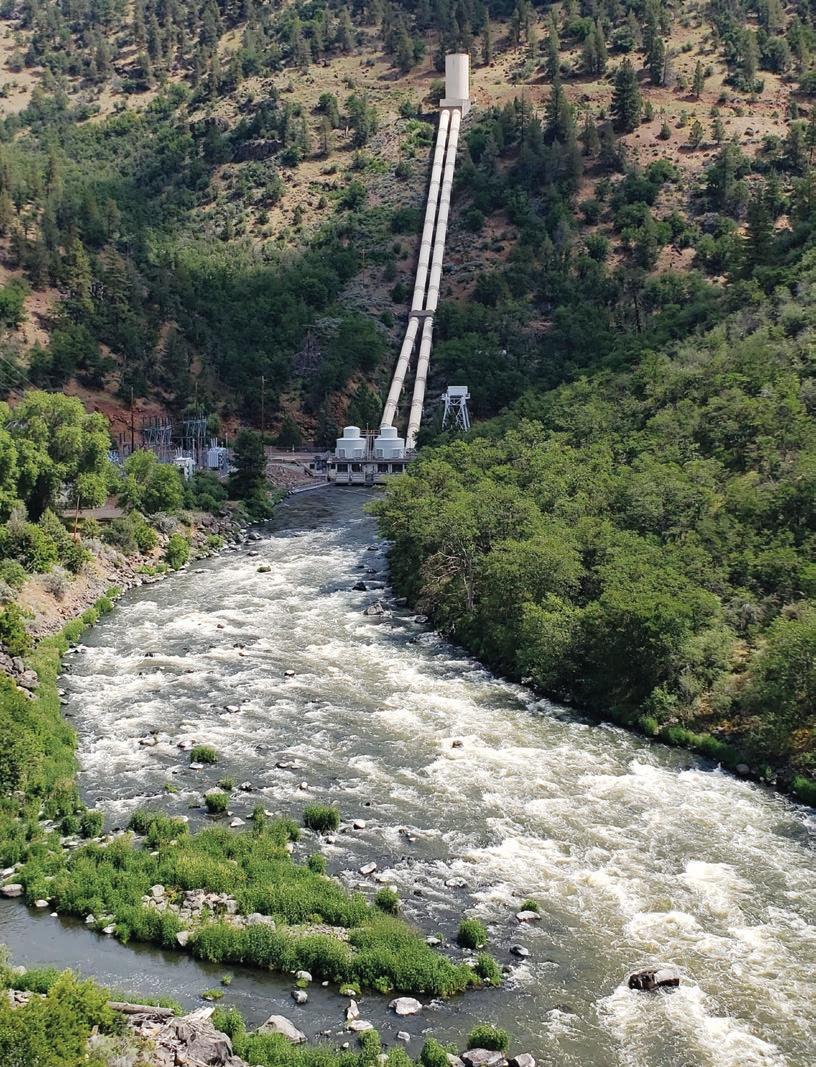
“It’s the same every day in summer,” says Pete Wallstrom, who owns Momentum River Expeditions. “May 1 through October, we know exactly what’s going to happen.” This consistency allows guides to learn the big water, making it safe to take a wide range of passengers down the run.
Offering this trip when people are looking for relief from summer heat has been a huge advantage, says Baldwin.
“That warm water, hot weather, big water—that’s the combination we’ll lose,” he says.
Although “river rats” are generally friends of wild rivers, local guides and outfitters will be giving up one of their biggest draws when the Klamath River dams are removed. Right now, the Hell’s Canyon trip represents about 50% of Noah’s business and one third of Momentum’s. Once the dams are gone, outfitters may still be able to run commercial trips on the Upper Klamath in spring, when flows are naturally high. But when the volume dwindles, it will be too risky to expose loaded rafts to the sharp volcanic rocks.
The owners of Noah’s, Momentum, and Indigo Creek, which account for the vast majority of commercial traffic on the Upper Klamath, formed the Upper Klamath Outfitters Association in 2005 to ensure they had a voice in the process as plans for dam removal inched forward. While they made an early decision to support dam removal, they’ve also been clear about what’s at stake for their businesses.
“We’ll have this season, and then we’ll have a season with no business and then we’ll have to rebuild on the new stretches,” says Wallstrom. “We understand this needs to happen for dam removal, but it’s also a challenge.”
Outfitters won’t be able to run the Upper Klamath at all in 2024, while the reservoirs are being drawn down and the dams deconstructed. Even as deconstruction begins, the outfitters have been adamant about not giving up their final season as they brace for the hit to their businesses next year.
This spring, they negotiated with the Klamath River Renewal Corporation, which is overseeing dam removal, on a compro-
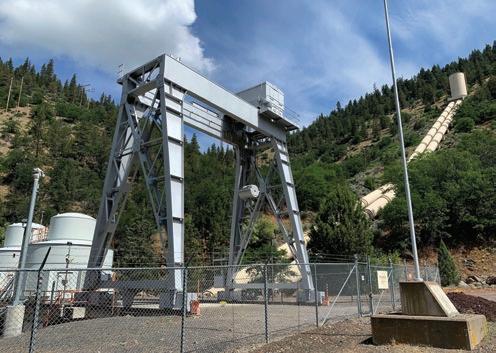
mise: they agreed to give up a week in June and to cut their season short in the fall so that Kiewit, the deconstruction contractor, can prepare for the drawdowns, which will begin in January.
“At this point it’s been a little bit of back and forth, but they hear us and they’ve conceded some things as well,” says Baldwin. “And so I believe we’re on track for a really good last year up there.”
The timing of the drawdowns was chosen to minimize the impact of sediment in the water for fish and spawning. Meeting that deadline is critical, says Mark Bransom, CEO of KRRC. “It’s important to note that if we are not prepared to undertake drawdown of the reservoirs in the January timeframe, we could very well lose an entire year.”
A new era of recreation
For decades, PacifiCorp maintained campgrounds, picnic areas, and boat ramps around the dam reservoirs. KRRC has already begun closing some of these; meanwhile, they are planning five new recreation sites with the help of GreenWorks,
SEPTEMBER/OCTOBER JEFFERSON JOURNAL | 15
a
Large pipes or “penstocks” that transfer water from the J.C. Boyle Dam to the J.C. Boyle powerhouse where two turbines generate electricity. The facility is operated by PacifiCorp and is one of four hydroelectric dams on the Klamath River that will be removed over the next year and a half.
inset: The J.C. Boyle Dam powerhouse on the Upper Klamath River is one of four dam facilities that will be removed in 2024.
PHOTO: JULIET GRABLE
PHOTO: ERIK NEUMANN
Outfitters won’t be able to run the Upper Klamath at all in 2024.












PROUDLY ANNOUNCES THE 2023-2024 SEASON AUDITIONS Youth Choruses: Thurs., Sept. 7 at St. Mary’s High School, 5pm Adult Chorus: Thurs., Sept. 7 at First Christian Church, 6–8pm Email to sign up and for more info: office@roguevalleychorale.org Sat., March 9, 3:00 PM Sat., May 18, 3:00 PM Concerts held at the North Medford High School Auditorium $15 Adults · $5 Youth/Students More information and tickets at roguevalleychorale.org Children’s Chorus Cantare Youth Ensemble Rogue Valley Chorale https://roguevalleychorale.org June 2024 Grizzly Peak Winery E. Nevada St., Ashland $60 incl. beer/wine tastings, food pairings, and concert ticket (21+ and over for the tastings) $30 Concert Only Tickets at roguevalleychorale.org Saturday, Dec. 2, 3:00 PM Sunday, Dec. 3, 3:00 PM Craterian Theater at the Collier Center for the Performing Arts $35 Adults $15 Youth/Students (22 and Under) Tickets available at craterian.org or by calling 541-779-3000 Saturday, April 6, 3:00 PM Craterian Theater at the Collier Center for the Performing Arts 23 S Central Ave, Medford Sunday, April 7, 3:00 PM SOU Music Recital Hall 450 S. Mountain Ave., Ashland $35 Adults $15 Youth/Students (22 and Under) Tickets available at craterian.org or by calling 541-779-3000 Hops 4 Pops Gathered as One MMasteriniatures Here Comes the Sun Second Annual ROGUE VALLEY YOUTH CHORUSES ROGUE VALLEY CHORALE ASSOCIATION ROGUE VALLEY CHORALE Dr. Jerron Jorgensen, Music Director Home for the Holidays Sou the rn Oreg on CONSERVAN CY L AND Become a me mber today! Your support helps permanently protect our region’s uniquely diverse plant and animal life, forests, grasslands, farms, and waterways. Become a member today and come to our annual picnic on Oct 21. Get early sign-ups for interpretive hikes with experienced naturalists and other inspiring experiences on our conserved lands. Join us for events, like Open Lands and Stewardship Days. For people. For nature. Forever. l landconser ve.org
Portland-based landscape architecture firm, and input from area tribes, residents, outfitters, fishing groups, and the states of California and Oregon.


The designers are considering everything from parking and accessibility to cultural resources, says Paul Agrimis, principal landscape architect at GreenWorks. “We are also thinking a lot about climate change and providing shade as we have hotter, dryer summers.”
Sites will include wheelchair-accessible fishing platforms, water-conserving toilets, and landscaping that blends with the restored reservoir footprints. Locations were chosen to steer visitors away from sensitive tribal cultural sites and to provide access to fishing and whitewater runs, some of them newly exposed or invigorated.
The powerhouse site below J.C. Boyle Dam will be revamped as Moonshine Falls. This new recreation site will serve as the takeout for the Upper Big Bend run, which is currently hidden under the J.C. Boyle reservoir, and the put-in for the Big Bend run, where water is currently diverted to feed the hydropower plant.
KRRC has landed a $3.5 million grant from the California Wildlife Conservation Board for the design and construction of the three new sites in California. One of these, called Copco Valley, will serve as the put-in for a new whitewater run called Ward’s Canyon.
KRRC will do some work to reduce hazards in Ward’s Canyon, which flows through a scenic basalt gorge between Copco 1 and Iron Gate dams. For decades, this section was dewatered to help feed the Copco 2 powerhouse. Now, cottonwoods clog the river channel.
“We’re going to remove a significant amount of vegetation,” says Bransom. “We’re going to break up some large boulders and try to reposition those to improve safety and boating conditions.”
Ward’s Canyon will make for a short but exhilarating run, with several Class 3 and 4 rapids stacked one on top of another. Because of its easy access and proximity to Interstate 5, it’s likely to be popular with commercial and private boaters alike.
“There’ll be something that’s open that has never been open to commercial whitewater boating,” says Baldwin, who has run Ward’s Canyon a few times. It’s fun, but short, he says, “It’s not as big and technical as the Hell’s Corner reach.”
In 2020, KRRC, PacifiCorp, and boaters collaborated on a “flow study”: PacifiCorp released water from J.C. Boyle to simulate different flow conditions; rafters and kayakers ran sections of the river and reported back on the potential hazards and opportunities.

Without the dams, the Klamath River will run free for 250 miles to the ocean, possibly opening up new options for multiday trips. But though the study gave outfitters a taste of what’s to come, they won’t really know what some of these runs are like — in particular, the ones that are submerged under the reservoirs — until the dams are removed. Baldwin and Wallstrom aim to get their boats back on the Upper Klamath as soon as possible in 2025 so they can learn the new runs and start marketing trips.
Witnessing history
The one-day trips that local outfitters run through Hell’s Canyon last most of the day. Guides draw out the experience by pulling the boats ashore above the first big rapid and pausing halfway for lunch.
This stretch of Wild and Scenic river is special not just for its exhilarating rapids, but because of its remoteness: no roads and few people, but you’re almost guaranteed to spy bald eagles and ospreys soaring above.
“Rivers allow you to see a certain area from a much different perspective than you might normally hiking on a ridge looking down upon it,” says McLennan. “You’re floating on the lowest point in the valley looking back up on everything.”
Wallstrom says that so far, the 2023 season has been their best ever. He hopes people will seek out the new Klamath River trips in 2025 — not just to support local rafting companies, but so they can witness the healing river.
“I’m just so excited to see a healthier Klamath River,” says Wallstrom. “Hell’s Canyon is an incredible way to introduce people to whitewater, but at the same time what allows that is very unhealthy for the river, and we love rivers.”

SEPTEMBER/OCTOBER JEFFERSON JOURNAL | 17
Juliet Grable is a writer based in Southern Oregon and a regular contributor to JPR News. She writes about wild places and wild creatures, rural communities, and the built environment.
Erik Neumann is JPR’s news director. He earned a master’s degree from the UC Berkeley Graduate School of Journalism and joined JPR as a reporter in 2019 after working at NPR member station KUER in Salt Lake City.
Rafters with Indigo Creek Outfitters from Phoenix, Ore. take their first paddle strokes after departing from Spring Island on the Upper Klamath River in June 2023.
PHOTO: JULIET GRABLE
PHOTO: ERIK NEUMANN
A raft from Noah’s River Adventures hitting the first small rapids after departing from Spring Island on the Upper Klamath River in June, 2023.
Without the dams, the Klamath River
will
run free for 250 miles to the ocean, possibly opening up new options for multi-day trips.










Medford buttercloudbakery.com 315 South Front St.
Director Deeply moving inspirational choral music! Water Night October 28, 2023, 7:30 pm October 29, 3:00 pm This concert combines passionate poetry with beautiful music by composers from the Renaissance to today, including William Byrd, Brahms, Eriks Ešenvalds, Eric Whitacre, Sarah Quartel, and Reena Esmail. All Concerts are at the SOU Music Recital Hall 450 S. Mountain Ave., Ashland, Oregon www.repsingers.org 541-552-0900
Cindy Triplett Saturdays at 9pm on Rhythm & News Since 1993 Terry
provides a lively look at entertainment and the arts, combined with in-depth personality interviews, to make you feel like you’re in the middle of the arts scene. Weekdays at 3pm & 7pm Fresh Air Weekend Sundays at 2pm JPR’s News & Information Service
Dr. Paul French, Music
Artwork by
Gross
Seeing The Rogue Valley In Lahaina
In his Facebook videos from the first days after the fire in Lahaina on the Hawaiian island of Maui, the look on Nicholas Winfrey’s face was painfully relatable. It was in the distant stare as he described the situation and in the sheer disbelief in his voice about the things he was saying. “Currently communication lines are still down in Lahaina – for what’s left of Lahaina. And really, we just don’t know what we don’t know,” he said. Winfrey is the president of Maui United Way, the local branch of the social services provider that steps into to help communities with any number of needs, be it education, economic mobility or nutrition. I saw the social media videos after they were shared by our local Jackson County United Way. Winfrey described a community coming together to provide food and shelter, and grappling with the long term help they’d be needing. “We do know that Lahaina is not what Lahaina was,” he said.
The wildfire that started on Aug. 8 in Maui resulted in 115 deaths (as of this writing) making it the deadliest U.S. wildfire event in the past century. Before that, the deadliest wildfire was the Camp Fire in Paradise, California in 2018, which took 85 lives. The Maui fire destroyed or damaged more than 2,200 structures including most of Lahaina. FEMA estimates it will cost $5.5 billion to rebuild.
Seeing the images of charred cars, blackened sticks that had been trees, and homes reduced to monochrome piles of ash, it was impossible for me not to remember the same destruction that happened in the Rogue Valley in 2020. Three years ago this September, the Almeda Fire tore through the communities of Phoenix and Talent, as wildfires simultaneously torched other parts of Oregon and California. The similarities don’t end there. Both the Almeda and Lahaina fires were driven by high winds, making them impossible to control. Water systems failed during both disasters, cutting off critical tools for firefighters. In both places, the frailty of our emergency alert systems became apparent as cell phone towers burned and power was cut, leaving residents with little warning about what was happening until they saw the oncoming smoke. In Lahaina, none of the community’s 80 warning sirens went off during the fire, according to reports. These two disasters differ in the incredible
loss of life Hawaii endured. Three people died as a result of the Almeda Fire.
Recovery on Maui could be even slower than in the Rogue Valley because of the basic logistical challenges that come with living on an island: everything from disposing debris to getting new building materials will take more time. According to Nicholas Winfrey’s initial Facebook videos, all of the affordable housing in their community was destroyed. I’m not sure anyone understands the glacial speed of cleanup and rebuilding after a wildfire without having experienced it. At JPR, our reporters are still covering the slow housing redevelopment in the Rogue Valley after the Almeda Fire, now three years later. In one example, JPR reporter Jane Vaughan recently broke a story about modular homes that arrived in Phoenix intended for wildfire survivors, some of whom are STILL living in hotels. But as the homes were being installed, they were found to be uninhabitable because of leaking water, mold and not being built to code. The speed it takes to rebuild can feel maddening.
Most people around the country won’t understand what residents of Lahaina are now facing. But some residents of Southern Oregon and Northern California will, be it because of the Almeda Fire, Slater Fire, Mill Fire, or any number of others.
The wildfires in Lahaina happened in early August. This issue of the Jefferson Journal comes out in September. There’s a good chance, that as you read this, some other story will have swept across the headlines, pushing out the news of Lahaina in the same way the news cycle churned past the Almeda Fire. But the struggle that the Hawaiian town of 12,000 now faces is nowhere near over. This is more likely the time when the initial surge of outside support is slowing. If you, like me, are thinking about how to remember the devastating fires here in Oregon in 2020, consider offering support to the residents of Lahaina who are just starting to pick up the pieces.
• Maui United Way https://mauiunitedway.org/
• Hawaii Community Foundation https://www.hawaiicommunityfoundation.org/maui-strong

• Maui Economic Opportunity https://www.meoinc.org/

• Red Cross in Hawaii https://www.redcross.org/local/hawaii.html
• Salvation Army https://disaster.salvationarmyusa.org/
SEPTEMBER/OCTOBER JEFFERSON JOURNAL | 19 PRESS PASS
ERIK NEUMANN
Erik Neumann is JPR’s news director.
Organizations providing support in Maui:



945 S Riverside Ave • (541)779-2667 medfordfood.coop/ownership 10% OFF monthly owner coupons free tote 10% off first purchase voting rights & more Join the Co-op & Save! SUPPORT JPR WHEN YOU SHOP AT FRED MEYER Link your Rewards Card to JPR by logging into your account at www.fredmeyer.com/signin When you use your Rewards Card, you’ll earn rewards points and fuel points AND help JPR earn a donation from Fred Meyer. Each quarter, Fred Meyer will make a donation to JPR based on your accumulated spending.
Though the summer season has come to a close, Circles in the Sand will return for its annual sunset walk through the labyrinth on Saturday, October 14 in Florence, Oregon.

Circles In The Sand, A Walkable Art Experience, Winds Down A Successful Ninth Season
When the tide is low on the Southern Oregon coast, giant spiraling paths can be seen drawn in the sand. In the spring and summer, people flock to Bandon to walk these artistic labyrinths that stretch out to the size of a football field.

This walkable, ephemeral art experience is known as Circles in the Sand. It wrapped up its ninth summer season on Saturday, August 5.
On a recent morning, volunteers prepared the beach for the final walk by running rakes through pristine sand on the beach at Face Rock State Scenic Viewpoint. This darkens the sand and highlights the path, which loops and swirls across the beach. A “detail artist” laid out white stones and carved shapes into the sand, images that looked almost like sunbursts. These intricate drawings are created for visitors to admire as they walk by.
Over the course of the morning, the beach transformed into a winding labyrinth. People from all over gathered on the sand, and Southern Oregon locals returned for an opportunity to meditate, to honor loved ones and to celebrate what has at this point become a coastal tradition.
Before the walk began, Denny Dyke, creator of Circles in the Sand, greeted visitors at the entrance to the labyrinth with a welcome speech and a thank you to the volunteers who raked around the path.
“My team and I, we just love what we do,” Dyke said. “And I think that is shown in our art, and everything else.”
Dyke, a generous hugger and a charismatic leader, has enjoyed the art of the labyrinth for a long time. He said creating these works of art is a kind of meditation for him that he loves to share with others.

“Oh, what an honor,” Dyke said. “What more can you do for somebody?”
The labyrinth is expansive. The path leads participants through spirals, squiggles, and loops that meander the beach, allowing visitors time to admire the shoreline, the massive sea stacks and the birds flying overhead. It takes about twenty minutes to walk in its entirety.
“It’s a single entrance, single exit, and you don’t have to worry about getting lost,” said Bethe Patrick, administrative director and detail artist for Circles in the Sand. “And that allows you to just let go, relax, meditate or just enjoy the scenery here at the ocean.”
At the entrance to the labyrinth, the words “leave behind what is not needed” are written in the sand. Circles in the Sand team members offer visitors a selection of colorful “dream stones” to choose from, hold and keep. Dream stones are a gift that every visitor gets in order to remember their walk.
Outside of the labyrinth is what’s called a dedication circle. About thirty feet in diameter, this circle is simple in comparison to the nearby walkable artwork, but it’s a space where visitors are free to draw, write and create their own artwork in the sand. They can write their name, or a loved one’s name, and dedicate their walk to them. Visible inside the circle are phrases like “For Emily,” “Happy B-Day Dad” and “I love you!”
Nancy Borglund and Jim Bell, who attended the Aug. 4 walk together, wrote a dedication inside the circle to Bell’s sister who passed away recently. Borglund said the walk is a nice way to reflect on the people in her life who have passed on.
“Everybody’s in the same frame of mind,” Bell said. “Just walking, everybody’s quiet, pretty much.”
“Very peaceful,” Borglund added.
Circles in the Sand takes place intermittently throughout the late spring and summer, depending on the tides. The labyrinth is scheduled to be in place for about two hours for the walk, but the tide will ultimately determine when it ends by washing the artwork out to sea.
SEPTEMBER/OCTOBER JEFFERSON JOURNAL | 21
ELLA HUTCHERSON
JPR NEWS FOCUS MUSIC, ARTS AND CULTURE
Visitors to Circles in the Sand walk the labyrinth on Aug. 5 in Bandon, Oregon.
Circles in the Sand allows visitors a peaceful, meditative walk on the beach at Face Rock State Scenic Viewpoint.
PHOTO: ELLA HUTCHERSON
PHOTO: ELLA HUTCHERSON
MUSIC FESTIVAL
eureka’s American Roots music festival
OCTOBER 5~8 · 2023
Thursday through Sunday in Historic & Waterfront Venues
JON DUKE
MICHAEL
CLEARY ROBILLARD DOUCET
HOT CLUB OF COWTOWN
DIUNNA GREENLEAF & BLUE MERCY with special guest JIM PUGH
KID RAMOS · MARK HUMMEL· OSCAR WILSON
JOEL PATERSON TRIO · CARL SONNY LEYLAND
TOM RIGNEY & FLAMBEAU · CORNET CHOP SUEY
DAVE STUCKEY & THE HOT HOUSE GANG · CLINT BAKER JAZZ BAND
HAL SMITH'S MORTONIA SEVEN · HOLLAND & COOTS JAZZ QUINTET
CHARLIE HALLORAN’S TROPICALES · NEW ORLEANS NIGHT OWLS
MISS JUBILEE & THE YAS YAS BOYS · ST LOUIS STEADY GRINDERS
JONATHAN STOUT & THE CAMPUS FIVE featuring Hilary Alexander
KATIE CAVERA & THE LOST BOYS · DAWN LAMBETH QUARTET

DAVE STUCKEY'S HOOT OWLS · JONATHAN DOYLE SWINGTET
TWO TONE STEINY & THE CADILLACS with Danny Sandoval
GROOVUS · MARC CAPARONE’S BACK O’TOWN ALLSTARS
DAVE BENNETT & THE MEMPHIS SPEED KINGS
TOMMY HARKENRIDER’S MEMPHIS KINGS
GINO & THE LONE GUNMEN
JENNI & DAVID and THE SWEET SOUL BAND · SoHUM GIRLS
YOUNG & LOVELY JAZZ BAND · REDWOOD DIXIE GATORS · NICE & EASY

REDWOOD INTERFAITH GOSPEL CHOIR
KINGS OF WESTERN SWING featuring Dave Stuckey, Elana James, Whit Smith & James Mason
MARK HUMMEL’S CHICAGO BLUES PARTY with Oscar Wilson, Joe Beard & Billy Flynn
C SPECIAL GUESTS c
MANDO DORAME · DAN BARRETT · TJ MULLER
DAVE BENNETT · ANDY SCHUMM · KRIS TOKARSKI
4 DAYS •7 STAGES •40 BANDS
DANCE FLOORS in EVERY VENUE
OVER 100 SETS of LIVE MUSI C
New Orleans Hot & Traditional Jazz · Swing · Blues
Americana · Western Swing · Country · Rockabilly · Zydeco
JPR News Focus: Arts & Culture
Continued from previous page
According to Patrick, nothing is drawn out in advance; the team comes out to the beach and creates their design based on what the sand looks like that day. But themes for each day, such as ocean or zen, determine what kinds of detail artwork Patrick will do.
“I love doing this,” Patrick said. “Just to listen to the surf and draw some art and just make this cool thing. And we get to meet all of these people.”
Though the summer season has come to a close, Circles in the Sand will return for its annual sunset walk through the labyrinth on Saturday, October 14 in Florence, Oregon.

Ella Hutcherson is a recent University of Oregon graduate from Coos Bay, Oregon. She came to Jefferson Public Radio through the Charles Snowden Program for Excellence in Journalism. Previously, Ella worked as education reporter for the Eugene Weekly and she was the managing editor of the UO student-run Ethos Magazine

NJn
NJn
REDWOOD COAST MUSIC FESTIVAL 2023 • SUBJECT TO CHANGE RCMFEST.ORG Since 1991
PHOTO: ELLA HUTCHERSON
PHOTO: ELLA HUTCHERSON
The dedication circle gives people a space to participate in the artwork at Circles in the Sand.
Bethe Patrick, administrative director and detail artist, and Denny Dyke, creator of Circles in the Sand.
Oregon Joins West Coast States Seeking Millions To Create Zero-Emission Truck Fueling Network
Two years ago, Oregon joined California and Washington in requiring school bus, delivery van, garbage truck and semitruck manufacturers to begin offering more zero-emission vehicles fueled by electricity and hydrogen.
Now, the three states are joining together with a plan to power them on drives on the West Coast.

The Oregon Department of Transportation and California and Washington’s transportation agencies submitted a joint application last month to the U.S. Department of Transportation for federal funding to build the West Coast Truck Charging and Fueling Corridor.

The plan involves building 34 medium- and heavy-duty electric vehicle charging stations and five hydrogen fueling stations primarily along 1,400 miles of Interstate 5 and its corridors leading to major freight hubs in San Diego, Los Angeles, San Francisco, Portland and Seattle.
Medium and heavy-duty trucks account for nearly 30% of the U.S.’s total greenhouse gas emissions, according to the U.S. Environmental Protection Agency. Transportation, including freight, is the largest source of greenhouse gas emissions in Oregon, the state Department of Environmental Quality says.
State agencies are unable to disclose the amount they’ve asked for because their application is under review, according to Matt Noble, a spokesperson for Oregon’s transportation department. The program they applied to is offering up to $700 million in grants for the year.

In a May letter to U.S. Department of Transportation Secretary Pete Buttigieg, 39 California members of Congress advocated for federal help funding the West Coast Truck Charging and Fueling Corridor, which was described as a first-of-its-kind project that would benefit people disproportionately impacted by heavy-duty vehicle emissions.
“The cities and regions that will benefit from this project constitute the majority of the most polluted areas in the United States, based on the major categories of air pollution tracked by the American Lung Association,” they wrote.
Then last month, California Energy Commission officials discussed applying for federal funding at a meeting, according to the electricity policy publication RTO Insider. State officials hope their application is approved this year under the first round of Charging and Fueling Infrastructure grants included in the Bipartisan Infrastructure Law passed by Con-
Daimler’s eCascadia and the eM2 are two of the first electric semitrucks to hit the highways. A new network of stations up and down the West Coast could accelerate the adoption of more electric vehicles across the region.

gress in 2021. The grant will provide $2.5 billion over five years for alternative fueling infrastructure on major roads and interstates across the U.S. The federal government will pay up to 80% of projects, with applicants funding the remainder.
Portland-based Daimler Truck North America and Florida-based NextEra Energy and global investment firm BlackRock are also collaborating on a nationwide, $650 million privately funded alternative-fuel charging network called Greenlane. It includes building out a West Coast network similar to that being pursued now by the Western state governments.
Daimler Truck is one of few truck manufacturers in the U.S. building heavy-duty electric vehicles for freight. Sean Waters, vice president of compliance and regulatory affairs at the company, said in an email that Daimler supports and looks forward to working with the West Coast states as a potential private partner in assisting with their truck charging and fueling corridor.
“Electrifying the commercial vehicle fleet is key to meeting the nation’s climate goals and will yield the greatest environmental benefits given the frequent use and vehicle miles traveled,” he wrote.
SEPTEMBER/OCTOBER JEFFERSON JOURNAL | 23
The Oregon Capital Chronicle is a professional, nonprofit news organization. We are an affiliate of States Newsroom, a national 501(c)(3) nonprofit supported by grants and a coalition of donors and readers. The Capital Chronicle retains full editorial independence, meaning decisions about news and coverage are made by Oregonians for Oregonians.
Alex Baumhardt has been a national radio producer focusing on education for American Public Media since 2017. JPR NEWS FOCUS
ALEX
BAUMHARDT
ENVIRONMENT, ENERGY AND TRANSPORTATION
left: West Coast Truck Charging and Fueling Corridor Project map.
Classics & News Service
4:00pm
5:00pm
Weekend Edition
FM Transmitters provide extended regional service. (KSOR, 90.1FM is JPR’s strongest transmitter and provides coverage throughout the Rogue Valley.)

Translators provide low-powered local service.





Translators
9:00am
WFMT Radio Network Opera Series
Sept 2 – Tannhäuser by Richard Wagner
Sept 9 – The Ballad of the Canal by Yin Qing


Sept 16 – La Fille du Regiment by Gaetano Donizetti
Sept 23 – La Fanciulla del West by Giacomo Puccini
Sept 30 – TBA
Oct 7 – TBA
Oct 14 – TBA
Oct 21 – TBA
24 | JEFFERSON JOURNAL SEPTEMBER/OCTOBER 2023 STATIONS & PROGRAMS
Morning Edition 7:00am First Concert 12:00pm Siskiyou Music Hall
All Things Considered 6:30pm The Daily 7:00pm Exploring Music
State Farm Music Hall
Weekend Edition 8:00am First Concert 10:00am Metropolitan Opera 2:00pm Played in Oregon 3:00pm The Chamber Music Society of Lincoln Center
KSOR 90.1 FM ASHLAND KSRG 88.3 FM ASHLAND KSRS 91.5 FM ROSEBURG KNYR 91.3 FM YREKA KOOZ 94.1 FM MYRTLE POINT/COOS BAY KZBY 90.5 FM COOS BAY KLMF 88.5 FM KLAMATH FALLS KNHT 102.5 FM RIO DELL/EUREKA KLDD 91.9 FM MT. SHASTA KHEC 91.1 FM CRESCENT CITY KWCA 101.1 FM REDDING
Monday through Friday.. 5:00am
4:00pm
8:00pm
Saturday.. 5:00am
Stations
Big Bend 91.3 FM Brookings 101.7 FM Burney 90.9 FM Camas Valley 88.7 FM Canyonville 91.9 FM Cave Junction 89.5 FM Chiloquin 91.7 FM Coquille 88.1 FM Coos Bay 90.5 FM / 89.1 FM Etna / Ft. Jones 91.1 FM Gasquet 89.1 FM Gold Beach 91.5 FM Grants Pass 101.5 FM Happy Camp 91.9 FM Lakeview 89.5 FM Langlois, Sixes 91.3 FM LaPine/Beaver Marsh 89.1 FM Lincoln 88.7 FM Mendocino 101.9 FM Port Orford 90.5 FM Weed 89.5 FM
FM
All Things Considered
Oct 28 – TBA New York Philharmonic 7:00pm State Farm Music Hall
Sunday..
Millennium of Music
Sunday Baroque
American Landscapes
Fiesta!
Performance Today Weekend 4:00pm All Things Considered 5:00pm Chicago Symphony Orchestra 7:00pm State Farm Music Hall
5:00am
10:00am
12:00pm
1:00pm
2:00pm
PHOTO COURTESY WFMT
A scene from NCPA's The Ballad of the Canal.
Rhythm & News Service
News & Information Service














SEPTEMBER/OCTOBER JEFFERSON JOURNAL | 25 STATIONS & PROGRAMS
Monday through Friday.. 5:00am Morning Edition 9:00am Open Air 3:00pm Q 4:00pm All Things Considered 6:00pm World Café 8:00pm Folk Alley (M) Mountain Stage (Tu) American Routes (W) The Midnight Special (Th) Open Air Amplified (F) 10:00pm Turnstyles 3:00am World Cafe Saturday.. 5:00am Weekend Edition 9:00am Wait Wait...Don’t Tell Me! 10:00am Radiolab 11:00am Snap Judgement 12:00pm E-Town 1:00pm Mountain Stage Monday through Friday.. 5:00am BBC World Service 7:00am 1A 9:00am The Jefferson Exchange 10:00am Here & Now 12:00pm BBC Newshour 1:00pm Today, Explained 1:30pm The Daily 2:00pm Think 3:00pm Fresh Air 4:00pm PRI’s The World 5:00pm On Point 6:00pm 1A 7:00pm Fresh Air (repeat) 8:00pm The Jefferson Exchange (repeat of 9am broadcast) 9:00pm BBC World Service Saturday.. 5:00am BBC World Service 7:00am Inside Europe 8:00am Day 6 9:00am Freakonomics Radio 10:00am Planet Money 11:00am Hidden Brain 12:00pm Living on Earth 1:00pm Science Friday 3:00pm To the Best of Our Knowledge 5:00pm Radiolab 6:00pm Selected Shorts 7:00pm BBC World Service Sunday 5:00am BBC World Service 8:00am On The Media 9:00am Throughline 10:00am Reveal 11:00am This American Life 12:00pm TED Radio Hour 1:00pm The New Yorker Radio Hour 2:00pm Fresh Air Weekend 3:00pm Milk Street Radio 4:00pm Travel with Rick Steves 5:00pm To the Best of Our Knowledge 7:00pm BBC World Service
KSMF 89.1 FM ASHLAND KSBA 88.5 FM COOS BAY KSKF 90.9 FM KLAMATH FALLS KNCA 89.7 FM BURNEY/REDDING KNSQ 88.1 FM MT. SHASTA KVYA 91.5 FM CEDARVILLE/ SURPRISE VALLEY
KSJK AM 1230 TALENT KAGI AM 930 GRANTS PASS KTBR AM 950 ROSEBURG KRVM AM 1280 EUGENE KSYC 103.9 FM YREKA KHWA 102.3 FM MT. SHASTA/WEED KPMO AM 1300 MENDOCINO KNHM 91.5 FM BAYSIDE/EUREKA KJPR AM 1330 SHASTA LAKE CITY/ REDDING Translators Callahan/Ft Jones 89.1 FM Cave Junction 90.9 FM Grants Pass 97.5 FM Port Orford 89.3 FM Roseburg 91.9 FM Yreka 89.3 FM Translators Ashland/Medford 102.3 FM Klamath Falls 90.5 FM / 91.9 FM Grants Pass 97.9 FM Redding 96.9 FM Roseburg 96.3 FM Eugene 98.7 FM FM Transmitters
FM Translators
AM Transmitters
FM Transmitter FM Translators
low-powered
3:00pm Folk Alley 5:00pm All Things Considered 6:00pm American Rhythm 8:00pm The Retro Cocktail Hour 9:00pm The Retro Lounge 10:00pm Late Night Blues 12:00am Turnstyles Sunday.. 5:00am Weekend Edition 9:00am TED Radio Hour 10:00am This American Life 11:00am The Moth Radio Hour 12:00pm Jazz Sunday 2:00pm American Routes 4:00pm Sound Opinions 5:00pm All Things Considered 6:00pm The Folk Show 9:00pm WoodSongs Old-Time Radio Hour 10:00pm The Midnight Special 12:00am Turnstyles
Stations
Stations
provide extended regional service.
provide low-powered local service.
provide extended regional service.
provide
local service.
Masterworks 1: Dvořák & Smetana
Ashland, Medford, & Grants Pass
Masterworks 2: Franck & Debussy Medford, Medford, & Ashland

October 20-22, 2023
September 22-24, 2023
Featuring Mary Elizabeth Bowden, trumpet

Masterworks 3: Mozart & Bruch

Don’t miss out! Get your tickets today by scanning the QR code to the left with your phone’s camera app, or call (541) 708-6400 to speak with our box office.
Ashland, Medford, & Grants Pass
November 10-12, 2023
Featuring Bella Hristova, violin

There is more music yet to come - stay tuned!


Erich Franz Schimps, Arcata – 1978 BMW R80/7
“I found my [1978 BMW R80/7] in an old shed, just sitting there abandoned… a mechanic went through it and restored it. I rode it for a good ten or fifteen years. I had a number of more modern machines but didn’t like them that much, so I reverted back to the old style.
I started riding in Germany way back in the 1950s and travelled all over Europe. I shipped [a motorcycle] back to New York and rode it to Mexico and then to Alaska. The Alcan Highway wasn’t paved in those days. We were in Fairbanks the day statehood was declared so everyone was partying all night.
I’m a fifty-five-year motorcycle rider and no longer wish to ride. I wanted to give [this motorcycle] a good home. I’m just so fond of JPR, so I thought ‘why not?’. I go to sleep listening to JPR’s Classics & News service around midnight and wake to the morning news. [This donation] will help continue their good work.”
Hassle Free · Tax Deductible · Free Pickup

Wrap yourself in the comfort of music...
...with Rogue Valley Symphony’s 2023/2024 Season! Our first three Masterworks concerts are sure to amaze!
Welcome to Reality 2.0

I recently watched a side-by-side video of Joshua Avatar 2.0, which is an A.I.-generated avatar and voice clone of its creator Joshua Xu. Both videos of Joshua look and sound very real. I showed the side-by-side video to my wife and lied to her.
“One of these is A.I.-generated and the other is real,” I told her. “Which one is the real one?”
She watched the videos closely.
“I don’t know for sure,” she said. “Maybe the one on the left?”
“Wrong!” I told her. “They’re both A.I.-generated avatars and voice cloning!”
(I know, I know: a jerk move, but you can get away with such things when you’ve been married for 30+ years. Also, don’t take marriage advice from me.)
I warned of this coming reality apocalypse in my 2021 column “Our Deep Fake Future”, which highlighted the emerging use of A.I. software to create “deepfake” pictures and videos:
Our deepfake future is quickly arriving and we’re not ready for it. Of all the dystopian futures I’ve imagined, faking ourselves to death hadn’t, until now, been one of them…In the short-term, increasingly sophisticated and ubiquitous [A.I.-generated] deepfakes will erode our trust in audio and video as reliable mediums for documenting what really happened…In the long-term, deepfakes will become sophisticated and elaborate enough to credibly manufacture entire events. Or worse—real events will be replaced with deepfakes, essentially overwriting history.
Well, I was wrong. The “long-term” has very quickly become the “short-term”. With rapid advancements in A.I.-generated content, we’re already there. Our reality will be increasingly influenced and shaped by that which has been digitally altered or outright created in order to influence what we think is true. What we think is true shapes our perception; it influences our beliefs and attitudes and becomes our worldview.
The promise of the global Internet and information sharing was that it would help us to better understand the world and ourselves. It has certainly done that, but I feel as though the “golden age” of that (if there ever really was one) has passed and the nexus of social media and A.I. proliferation has built a oneway bridge for us to cross the Rubicon at a full sprint.
Design is destiny and with social media and now highly realistic A.I.-generated content, we’ve designed a system that is destined to make it increasingly difficult for us to know what is real and what is not. A.I. companies are releasing powerful A.I. content-creation tools in a race to be first to market. Combine that with global social media platforms in which everyone is a publisher who can easily reach millions and you have a system that is ripe for being used to produce and distribute misinfor-
mation that will shape the reality of those who consume it.

Design is destiny and governments and/or state-sponsored actors will be using these A.I. tools too. Most likely they’ve already been using them. I can think of at least a couple of three-letter-agencies who likely developed powerful A.I. tools and systems years ago and have already been operationally using them to influence and shape world events as well as public perceptions of those events. This isn’t “conspiracy theory”, it’s just the rational outcome of the existence of such tools paired with the missions and cultures of intelligence agencies.
Meanwhile, the Biden administration is expediting the development of an executive order to address the risks posed by A.I. and provide guidelines for federal agencies regarding its development and use. Additionally, the administration has promised to “pursue bipartisan legislation to help America lead the way in responsible innovation” and to “seize the tremendous promise and manage the risks posed by Artificial Intelligence and to protect Americans’ rights and safety.”
That’s great and much needed, but it feels like too little too late. I hope I’m wrong about that and this is just another instance in which the speed of government lags way behind the speed of technological development.
In the meantime, how will you and I know what is true? How will we know that the video we’re watching is real and wasn’t created by A.I.? How will we know that the voice we’re listening to—perhaps that of a politician or a celebrity—is really that of the person or was manufactured by A.I.?
In the past, the public has relied on the news media to inform them about events and provide them with functional, factbased truths in order to make informed and rational decisions in their day-to-day lives. However, in a recent Gallup/Knight Foundation survey, 50 percent of Americans indicated they believe national news organizations intend to mislead, misinform or persuade the public to adopt a particular point of view through their reporting.
You may or may not be part of that 50 percent who no longer trust the news media to be the arbiters and purveyors of truth. But whether you are or not, we’re all in this together and we’re not going to make it if we’re increasingly living in bifurcated bubbles of reality.
Design is destiny and my fear is that unfettered A.I. is going to further splinter our reasonably shared reality, which is the glue that holds a nation together.
SEPTEMBER/OCTOBER JEFFERSON JOURNAL | 27
INSIDE THE BOX
Scott Dewing is a technologist, teacher, and writer. He lives in the mythical State of Jefferson.
DEWING
SCOTT
Subscribe where you get your podcasts.
Subscribe where you get your podcasts.








Available on Spotify, Google, and Apple Podcasts. More information at ijpr.org/podcasts
Available on Spotify, Google, and Apple Podcasts. More information at ijpr.org/podcasts
























Planned repair work on Winchester Dam near Roseburg has led to emergency salvage efforts for Pacific lamprey.
Dam Repairs On North Umpqua River Cause Emergency Lamprey Salvage, Concerns About Steelhead
An estimated 50–60 staff from state and federal agencies and the Cow Creek Band of Umpqua Tribe of Indians attempted to salvage juvenile Pacific lamprey in early August, after the reservoir behind Winchester Dam was drained to make way for repairs starting Aug. 7. According to a spokesperson with the Oregon Department of Fish and Wildlife, the emergency salvage effort involves removing juvenile lamprey from the shore and returning them to the North Umpqua River.
“We are definitely concerned about the juvenile Pacific lamprey in the substrates upstream of the reservoir. We are assisting with an emergency salvage,” said Michelle Dennehy, a spokesperson with ODFW.
The 16-foot-high wood and cement Winchester Dam sits alongside Interstate 5 near Roseburg, Oregon. Below it, the highway crosses the river on a bridge. Upriver from the dam, long, manicured grass lawns stretch down to the banks of the reservoir.
Starting on Aug. 7, excavators and backhoes began assembling a makeshift road through the river rocks with large “supersacks” of sand and gravel so they could work on a few areas of the dam’s face where water has been seeping through the 133-year-old structure.

The repair work, which was expected to be complete on Aug. 28, includes reinforcing the dam face with concrete and steel, and filling voids in the dam with injected polyurethane foam. The repairs have frustrated environmentalists, who say temporarily closing the dam’s already outdated fish ladder will further stress fish species like steelhead, lamprey and Oregon Coast coho salmon, which are listed as threatened under the Endangered Species Act. And they say the aging, privately owned dam on the North Umpqua River that primarily benefits local residents should not be allowed to exist in the first place.
“We have collapsing runs in the North Umpqua. We’d like to address some of the stresses on those fish to arrest that decline,” said Jim McCarthy, the Southern Oregon program director for WaterWatch, an environmental nonprofit focused on protecting rivers in Oregon.
Winchester Dam was built in 1890 to generate hydropower for the City of Roseburg. In 1969, the utility that owned it, PacifiCorp, decided it no longer wanted the dam. It was given to the 154 landowners who live around the banks of the resulting 1.7-mile long reservoir, which is used primarily for recreational activities, like water skiing.
Residents with the Winchester Water Control District, who own the dam, say they’re the best stewards of the river, and the repairs will help ensure the long-term health of the North Umpqua’s renowned upriver fishing habitat by keeping out invasive species that get stopped at the dam.
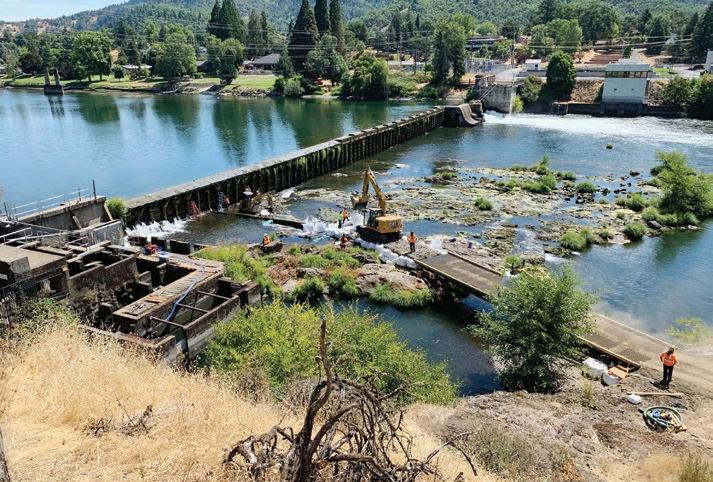
“My family has had a home here for three generations with this reservoir behind it. If it was harming fish, the people that live behind it would be the first ones to pony up,” said Ryan Beckley, the president of the Winchester Water Control District and the owner of TerraFirma Foundation Systems, the contractor repairing the dam.
Disputes about Winchester Dam are not new. In 2020, WaterWatch offered to remove it at no cost to the water district, in an effort to increase fish passage to 160 miles of the North Umpqua and its tributaries upriver. But the district declined the offer. It’s currently listed in the top two dozen dams on the ODFW 2019 statewide fish passage barrier priority list, which ranks barriers, like dams, according to those which are in need of improved fish passage. The dam is ranked second in the state for those which are privately owned.
“It’s passing fish. But again, we also recognize that the dam is delaying migration. And that was one of the major reasons for moving it up on that statewide priority list,” said Greg Huchko, the Umpqua District fish biologist with the ODFW.
SEPTEMBER/OCTOBER JEFFERSON JOURNAL | 29 Continued on page 31
ERIK NEUMANN JPR NEWS FOCUS ENVIRONMENT
Construction crews working at Winchester Dam near Roseburg on Monday, Aug. 7, 2023. Crews were lowering water above the dam to prepare to make repairs on the privately owned dam.
PHOTO: ERIK NEUMANN/JPR
World-Class Musicians, Thrilling Performances
2023–2024 SEASON
Aizuri Quartet with Kinan Azmeh, clarinet
Friday, September 29 · 7:30pm
Praised by The Washington Post as “astounding” and “captivating,” the Aizuri Quartet was awarded the Grand Prize at the 2018 M-Prize Chamber Arts Competition and top prizes at the Osaka International Chamber Music Competition in Japan and the Wigmore Hall International String Quartet Competition in London.

Hailed as “intensely soulful” and a “virtuoso” by The New York Times, clarinetist/composer Kinan Azmeh has gained international recognition. Originally from Damascus, Syria, he was recently appointed to the National Council for the Arts on a nomination by President Joe Biden.

Carion Wind Quintet
Saturday, November 4 · 3pm
“No chairs. No music stands, nothing. The way Carion fill the stage with musical and emotional content is something remarkable”
Allgemeine Zeitung

The prize-winning Danish-Latvian Carion Wind Quintet fascinates with its carefully choreographed and dramatized performances, making music on stage visible and adding a new dimension to traditional concerts.
 Presenting world-class ensembles in the Southern Oregon University Music Recital Hall in Ashland, Oregon.
Presenting world-class ensembles in the Southern Oregon University Music Recital Hall in Ashland, Oregon.
TICKETS: ChamberMusicConcerts.org · 541-552-6154 · 541-552-6348
All concerts take place at the Southern Oregon University Music Recital Hall, 450 S Mountain Avenue, Ashland, Oregon.
JPR News Focus: Environment

Continued from page 29
In late July, all angling on the North Umpqua River and its tributaries was closed by ODFW until December because of low numbers of returning wild summer steelhead. “Current counts of wild summer steelhead passing Winchester Dam are just under half the amount needed to expect meeting critical abundance for the year,” reads a press release from the department. Still, Huchko says the current three-week closure of the Winchester Dam fish ladder is not expected to have a “population scale” impact on returning steelhead, since the vast majority in that run should have already traveled up river. Construction permits for the project were approved by numerous agencies, including the Oregon Department of Environmental Quality, Army Corps of Engineers and the National Marine Fisheries Service. ODFW chose the Aug. 7-28 work window based on when construction would have the least impact on summer steelhead.
Anglers like Rich Zellman disagree. Zellman is a fishing guide on the North Umpqua and board member of the Steamboaters, a conservation group focused on the river, for which McCarthy is also a member.
“There’s too few summer steelhead this year to even risk losing one of them,” Zellman said.
He said Huchko with ODFW released the 20 wild steelhead that the agency had in this year’s hatchery program back into the river because the run’s numbers were so low.
“That told me a lot,” Zellman said.
Fishermen like Zellman say the current three-week fish ladder closure to accommodate construction is too long and it could prevent migrating fish from traveling into the cold tributaries upriver. According to Huchko with ODFW, steelhead numbers are low this year because of a variety of factors, including unusually warm temperatures in the mainstem of the Umpqua River, increased predation from non-native striped bass and smallmouth bass and poor ocean conditions.
Beckley, the water district president, argues that the existence of the dam, and a fish ladder that some say is outdated, protects steelhead in the upriver habitat by keeping out predatory bass that can’t swim up the ladder.
Environmentalists like McCarthy also say the water district cuts corners on repairs and that it’s not held to a high enough standard by public agencies. During the first week of dam repairs after water was drained from the reservoir, WaterWatch released an emergency press release about the Pacific lamprey, which they estimate is affecting “hundreds of thousands” of juveniles that live along the river’s muddy shores because too few staff had been hired to help remove them as reservoir levels were lowered.
Dennehy with ODFW said it will take time to determine the number of lamprey that have been killed.
When WaterWatch helped remove the similar sized Gold Ray Dam on the Rogue River in 2010, McCarthy says ODFW did not allow them to stop fish passage for any amount of time, let alone three weeks. He says agencies could have required the

Winchester Water Control District to repair the dam in ways that are more friendly to fish species, even if they cost more.
“So, the question is not one of repair the dam or not. The question is repair the dam right or not. And what they chose is to repair the dam in a sloppy way that has the highest impact to the run. We thought that was inappropriate. We thought that was poor judgment on behalf of the agency,” McCarthy said.
When the water district did repairs on the Winchester Dam in 2018, the contractor at the time, Basco Logging, Inc., accidentally discharged sediment and wet concrete into the river, killing fish and violating water quality standards, including negatively affecting the downriver drinking water sources for the City of Roseburg and the Umpqua Basin Water Association. The Oregon Department of Environmental Quality issued a civil penalty of $58,378 but Basco appealed DEQ’s fine and got it lowered to $19,517, according to a spokesperson for the agency.
The work on the dam was expected to last until Aug. 28. Despite concerns from groups like WaterWatch and the Native Fish Society, no violations have been confirmed for the construction. Beckley, the contractor and water district president, says he will make sure the dam isn’t causing problems to fish on the North Umpqua River.
“I absolutely know that if I had any inclination or indication that it was doing damage, that the people that live here have the means and the resources to correct that and that we would,” he said.
SEPTEMBER/OCTOBER JEFFERSON JOURNAL | 31
Erik Neumann is JPR’s news director.
The Winchester Dam fish ladder. Residents who own the dam and environmental groups disagree on the effectiveness of the fish ladder.
PHOTO: KIRK BLAINE/NATIVE FISH SOCIETY

Oregon has spent more than $25 million housing 462 kids in foster care in hotels after the state promised to stop the practice as part of a legal settlement in 2018.
Oregon Continued To Put Foster Kids In Hotels For Years, Defying Legal Settlement
On Tuesday, a federal judge took the rare step of appointing an outside expert to oversee the state’s Department of Human Services, noting the state agency has not figured out how to wind down the practice known as “temporary lodging” on its own.

The state has not only failed to curb the practice, child welfare officials have increasingly relied on placing kids in hotels. In the first six months of this year, 75 kids were placed in hotels; ranging in age from 6 to 19 years old. Twenty of those kids have lived in a hotel for more than 60 days.
“This is incredibly harmful for these kids,” said Maggie Carlson, an attorney for Youth, Rights & Justice, which was one of the groups that filed a lawsuit in 2016 to stop the practice of hoteling. “They are spending months and months in hotels with a rotating cast of caregivers all the while getting the message they are unwanted and can’t do well with a regular family and they are different and unlovable. It really affects their mental health in the long term.”
When the state of Oregon removes a child from their home, child welfare officials are responsible for their care and ensuring they receive any mental health care they might need. Placing vulnerable youth in hotels for extended periods of time is widely recognized — even among Department of Human Services officials who are responsible for the kids placed in state care — as an inappropriate placement.
Attorneys and advocates with Youth, Rights & Justice and the Oregon Law Center asked a judge earlier this year to consider placing a court-appointed special master, someone who could ensure Department of Human Services officials worked to end the practice of hoteling.
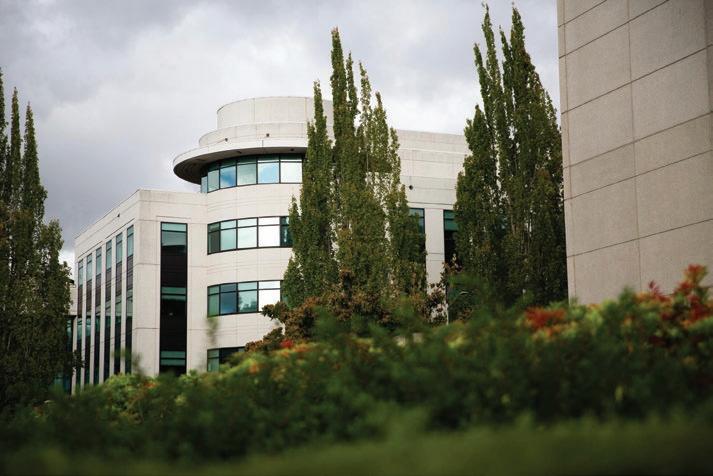
U.S. District Court Judge Michael McShane agreed this week and appointed Marty Beyer as special master to make specific recommendations to the court. Beyer will enter into a one-year contract with the state and spend the first three months gathering information before coming up with recommendations on how to find better placements for vulnerable children. The judge could then order the state to follow Beyer’s recommendations.
Oregon DHS officials offered a range of reasons why they struggle to find adequate places to house kids, such as a lack of capacity in both foster homes and residential treatment centers, the latter of which help treat kids with extensive behavioral health needs.
The state has struggled for years to find appropriate placements after kids have been removed from their family. When
the state started sending foster kids to dangerous out-of-state facilities, officials initially deflected blame by saying kids had such complex needs there was no adequate spot for them in Oregon.
In recent legal filings, advocates noted the state was again relying on the same rationale to explain the need for hoteling, writing the agency consistently failed to undertake systemic changes.
For seven years, the state has said there was a lack of suitable placements for kids and it was working diligently to increase capacity, McShane wrote, adding, “this argument has become nothing more than a stale mantra and the Court has lost faith in ODHS’ ability to end this entrenched policy on its own.”
A bigger problem
Annette Smith, a public defender representing kids placed in foster care, has watched the state struggle to find appropriate placements for kids for years. In 2019, she represented a 9-yearold girl who was sent to a facility in Montana where she was drugged and largely abandoned by the state of Oregon. Shortly after the young child’s story became public, a litany of other cases of abuse were raised and the facility was shuttered.
Smith currently represents a teenage boy who was placed in a hotel in Lane County for about 10 months.
“It’s tricky because I often represent kids who have been in (congregate care) programs before and … they would honestly rather be in a hotel room than in anoth-
SEPTEMBER/OCTOBER JEFFERSON JOURNAL | 33
JPR NEWS FOCUS
LAW AND JUSTICE LAUREN DAKE
The Oregon Department of Human Services building is pictured in Salem, Ore., on Sept. 26, 2019.
PHOTO: BRADLEY W. PARKS/OPB
Continued on page 35

JPR News Focus: Law and Justice
Continued from page 33
er program like that,” Smith said, adding because the congregate care facilities are also largely not ideal for most kids who are placed in foster care.
What is truly needed in Oregon for kids placed in foster care is in short supply, Smith said.

“(We need) really skilled, well-paid community based resource parents, or to the largest extent possible we keep kids within their family,” Smith said.

Smith is familiar with the state’s narrative: Kids’ needs are so complex that there isn’t anywhere else to put them, except a hotel or congregate care. And she said, she agrees, the state does struggle to find places to put kids, but that shouldn’t mean they end up lingering in a hotel room or shoved into congregate care programs that aren’t right for them.
“I think about all of the risks we were trying to mitigate when we do a removal in the first place,” Smith said. “So, we’re going to try and prevent them from being the victim of witnessing domestic violence. We’re going to try and prevent them from being assaulted or physically abused. We’re going to try and prevent them from being neglected. Then they end up experiencing those things in care, either in a hotel or congregate care or sometimes even in a foster home. So it kind of makes you wonder, what are we actually doing here?”
Possible solutions
One of the most universally agreed upon ways to increase foster care parent capacity is to reimburse people who offer it.
The current rate for foster care parents can range depending on the age and needs of the children in care, but the base payment for providing care is $693 a month for children ages 0 to 5; $733 per month for kids ages 6 to 12 and $795 a month for children ages 13 to 20.
The Legislature approved a rate reimbursement increase this session, which advocates believe could help but it is still shockingly lower than the $2,560 per night cost (which includes lodging, staffing and food) to house a child in temporary lodging.
“Putting aside the humanitarian concerns in this case, “temporary lodging” is financially wasteful,” lawyers for the Oregon Law Center, a nonprofit that provides free legal services for vulnerable groups, wrote.
Carlson, the attorney for Youth, Rights & Justice, said paying foster care parents more and offering them more support and training would help with recruitment.
The state also needs to provide culturally competent support systems.
“There is a significant racial disparity in the kids spending extremely long times in hotels,” Carlson said. “The kids who are being placed in hotels are disproportionately Black and brown children and the kids who are staying in hotels for months who are languishing there are disproportionately Black and brown children.”
Carlson said at this point advocates are worried the practice of placing kids in hotels is now entrenched.
“When it began in 2016, 2017, it was an anomaly,” she said. “And now there is a process, a procedure to place kids in hotels … it’s become a normal option for caseworkers.”
SEPTEMBER/OCTOBER JEFFERSON JOURNAL | 35
Copyright 2023 Oregon Public Broadcasting.
Lauren Dake is a political reporter and producer for Oregon Public Broadcasting.
MEDICINE
MARISA KENDALL
How California Is Fighting Meth With Gift Cards
Among the most difficult addictions to witness at San Francisco general hospital’s drug clinic is methamphetamine, which leaves users tearing at their skin and unable to eat, sleep or sign up for help.
The worst part: The clinic workers largely are powerless because unlike with opioid addiction, for which doctors prescribe medications such as methadone, there is no medicine for stimulant use disorder.
“We live day in and day out watching people suffer in a way that’s hard to imagine,” said Dr. Brad Shapiro, medical director of the Opiate Treatment Outpatient Program at Zuckerberg San Francisco General Hospital. “They’re just dying in front of us.”
Faced with that immense suffering, California will try a new approach to stimulant addiction: Paying people with gift cards to reward them for staying sober.
This model, known as “contingency management,” rewards people with financial incentives each time their drug tests are negative for stimulants. It’s been shown to have success in clinical trials — and the U.S. Department of Veterans Affairs has been using it for more than a decade — but it hasn’t taken off in California. Medicaid previously wouldn’t cover it, so there was no funding to expand its use.
To Shapiro, that’s inexcusable.
“It’s actually, in my opinion, really quite criminal that we’ve gone decades knowing this is an effective treatment and the powers that be have failed to make a pathway for treatment for people,” he said.
The program is expanding now, thanks to a recent waiver by the federal Centers for Medicare & Medicaid Services that allows the agency to cover its costs. California was the first state in the nation to win approval for a contingency management program under Medicaid. The Golden State is launching pilot programs in 24 counties, including San Francisco, Sacramento and Los Angeles. Costs for what collectively is called the Recovery Incentives Program will be reimbursed by CalAIM – the state’s recent expansion of Medi-Cal services.
“All of a sudden we have money to provide this incredibly effective intervention,” said Shapiro, whose clinic is launching one of three pilot programs coming to San Francisco. “So it makes a huge difference.”

Fighting meth with gift cards
Shapiro’s clinic focuses primarily on opioid addiction, but more than half of their patients also have a stimulant use disorder, he said.
While the deadly opioid fentanyl gets most of the attention in the drug epidemic in California and across the country, experts say stimulant use is a major — and growing — concern.
In 2021, 65% of drug-related deaths in California involved cocaine, methamphetamine or other stimulants — up from 22% in 2011, according to the California Department of Health Care Services. Nationally, there were 15,489 overdose deaths involving stimulants other than cocaine (largely methamphetamine) in 2019, up 180% from 2015, according to a study by the National Institute on Drug Abuse.
And with California in the midst of a dire homelessness crisis, stimulants are wreaking havoc on the state’s unhoused community. Among unhoused residents who use drugs, amphetamines are by far the most common choice, according to a recent study by the UCSF Benioff Homelessness and Housing Initiative. Nearly one-third of people surveyed reported using amphetamines three or more times a week, compared to just 11% who used opioids with the same frequency. Some people who live on the street reported using stimulants to stay alert at night, when they fear being attacked if they fall asleep.
To combat stimulant addiction among its patients, Zuckerberg San Francisco General Hospital recently launched a six-month contingency management program as part of the statewide pilot. The hospital opened enrollment on July 17, and staff hope ultimately to serve about 50 people. Clinicians will test participants for stimulants once or twice a week. Each time patients test negative, they’ll get a $10 gift card to Walmart or another retailer. The amount of the gift card gradually will increase, for a maximum of $26.50 per test. If they test positive, they get nothing.
36 | JEFFERSON JOURNAL SEPTEMBER/OCTOBER 2023
California’s experimental new program targets methamphetamine addiction by rewarding patients with gift cards for negative drug tests.
JPR NEWS FOCUS
HEALTH &
Drug test cups at the Opiate Treatment Outpatient Program at Zuckerberg San Francisco General Hospital on July 20, 2023. The program uses reward incentives to combat substance abuse and addiction.
CREDIT: MARK LEONG / CALMATTERS
Participants can earn a maximum of $599 over the course of the program. That’s because payments of $600 or more must be reported to the Internal Revenue Service.
Santa Clara County hopes to launch a similar program within the next few weeks. So far this year, 70% of the 120 drug deaths recorded in the county involved methamphetamine, according to the Office of the Medical Examiner-Coroner.

“We’re all excited to try it and see if it does help retain people in treatment for longer periods of time so they are more successful,” said Tammy Ramsey, program manager for the Drug Medi-Cal Organized Delivery System in the county’s behavioral health department.

ate bureaucratic hurdles to treatment as patients wait for the state to decide if they are eligible. Still, he said, the program is worth a shot.
“At this point I’m willing to try it, basically because we have such a dearth of options for people that are struggling with addictions in California,” he said.
Because of how difficult it is to treat his patients that use stimulants — many of them use methamphetamine every day — Shapiro would be happy if even a quarter of participants significantly reduced or stopped using. There is also concern, as with any type of treatment, that patients will relapse once the program is over, he said. To help prevent that, the hospital will provide six additional months of counseling after the contingency management program ends.
It’s not a perfect solution
Rewarding people for staying sober doesn’t work for everyone. Even before it was covered by Medi-Cal, Zuckerberg San Francisco General Hospital was experimenting with the model in small programs.
Contingency management works
Other programs in counties throughout California — including Alameda, Fresno, Nevada, Sacramento and Los Angeles — will follow the same model.
If the trials are successful, Shapiro hopes the state will allow them to expand and serve everyone on Medi-Cal.
The model already has proven effective for the Department of Veterans Affairs, according to Dominick DePhilippis, the department’s deputy national mental health director for substance use disorders. The VA started using contingency management in 2011, and as of the beginning of July, the program has treated more than 6,300 veterans. Those veterans have attended about half of their appointments and produced nearly 82,000 urine samples – of which more than 92% were negative for the targeted drug, DePhilippis said.
It’s not just the VA. Of 22 studies testing contingency management’s impact on stimulant addiction, 82% reported “significant increases” in participants’ abstinence, according to a 2021 meta-analysis published in JAMA Psychiatry.
Shapiro believes the model works because it replaces the reward a patient’s brain craves (the drug) with a different type of prize.
“It’s a little bit like winning something,” Shapiro said. “It triggers that reward place in the brain that otherwise they would be turning to the drug for.”
But Tom Wolf, who has battled addiction and homelessness himself and now advocates for drug policy reform, said he worries using Medi-Cal to fund contingency management will cre-
One of the participants in those programs, 54-year-old J.W., ended up in the emergency room with heart failure after two decades of methamphetamine use. After his hospital stay, he enrolled in a 12-week program called Heart Plus, which caters to cardiac patients with a history of stimulant use. Every time J.W. did something positive, such as show up to an appointment, take his medication or get a negative drug test, he got to draw a Safeway gift card out of a hat. The cards’ value ranged from $5 to the “elusive” $20, and J.W. — who asked to go by his initials out of fear of being stigmatized for his drug use — estimates he earned about $180 throughout the entire program. He wasn’t working at the time, so the cards helped him get treats such as deli sandwiches and fancy bottles of kombucha.
“It was definitely something to look forward to,” he said. “And it was something fun to spend.”
But it wasn’t enough to get J.W. off drugs. Now that the program has ended, he’s still using methamphetamine — sometimes as often as three times a day — though he says he’s taking smaller doses. And he said he feels much healthier than when he showed up in the emergency room last year, out of breath after the slightest amount of exertion.
J.W. isn’t sure why he didn’t quit using during the program. But methamphetamine has become an entrenched routine in his daily life. He uses upon waking up, in a ritual he compares to having a morning cup of coffee.
“I still kick myself wondering why I didn’t quit altogether,” he said. “There’s no better opportunity.”
SEPTEMBER/OCTOBER JEFFERSON JOURNAL | 37
CalMatters is a nonprofit, nonpartisan media venture explaining California policies and politics.
Marisa Kendall reports on California's homelessness crisis for CalMatters.
The Opiate Treatment Outpatient Program at Zuckerberg San Francisco General Hospital on July 20, 2023.
CREDIT: MARK LEONG / CALMATTERS
CHELSEA ROSE
The Razor’s Edge


October 11, 2023 marks the 100th anniversary of one of the most infamous crimes in Southern Oregon. This tale has train robbers, rumors of gold, dynamite, and all the intrigue of an old timey wild west crime overlaid on the backdrop of a rapidly modernizing world. Four innocent men brutally lost their lives on that day, and the ensuing manhunt captured the attention of the nation. As retold with more detail by Pepper Trail and Edgard Espinoza in this same issue, the botched robbery of a Southern Pacific train at Tunnel 13 high in the Siskiyou Mountains is not worth commemorating just for our regional brush with true crime fame, but because this case inadvertently created modern American criminal forensics.
As part of a collaborative effort to mark a century since the Tragedy at Tunnel 13, the Underground History team has been working on a series of podcasts to explore the legacy of this crime. We will be speaking with the Smithsonian National Postal Museum and the National Postal Inspectors Archives about the crime and history of mail cars on trains, which led to postal clerk Elvyn Daugherty’s untimely death in the robbery. The
postal inspectors, the law enforcement arm of the U.S. Postal Service, worked with the Southern Pacific Railroad in a multiyear, international effort to track down the three DeAutremont Brothers responsible for the grizzly crime. As a result of their role in this complex investigation which led to millions of wanted posters plastered around the world and a fateful decision to loop in Berkeley chemistry professor Edward Oscar Heinrich, this case is of great importance to the history of that agency. While crime labs existed in Europe at the time, Heinrich pioneered the practice in the U.S. by performing a variety of tests that helped identify the DeAutremont brothers as the wouldbe-train robbers-turned-murderers. His careful examinations deducted information about the men and their work, and a forgotten receipt deep in a pocket provided names.
The Tragedy at Tunnel 13 project has also brought us to the U.S. Fish and Wildlife Forensics Laboratory here in Ashland. The lab specializes in wildlife crime around the world, and also considers this case to be seminal in the formation of their discipline. In an effort to showcase the role of forensics in this hundred-year-old crime (and as an excuse to shoehorn myself into the lab to play with fancy toys) we asked Anna Sloan, curator of the Southern Oregon Historical Society (SOHS), to join us at the lab and bring by a straight razor held in the collections and attributed to the DeAutremont brothers prior to the robbery. Deputy laboratory director Barry Baker and forensic scientist Jen Tinsman helped us test the razor using a range of specialized equipment. No spoilers here (you have to listen to the show to

38 | JEFFERSON JOURNAL SEPTEMBER/OCTOBER 2023
UNDERGROUND
HISTORY
Deputy Director Barry Baker discusses forensic techniques with Underground History producer Charlie Zimmermann
Group selfie with Underground History host Chelsea Rose in the foreground and UH Producer Charlie Zimmerman on the right capturing sound. Catherine Venegas (center), Anna Sloan (far right) and Jen Tinsman (far center).
hear what we found!), but we gathered evidence from the razor that could date to the era of the crime. This process helped us better understand forensic techniques, and as a bonus, the results provided information about the material and condition of the artifact that will help SOHS better preserve it for the future.
While our stint in the forensics lab showcased some new-fangled technology that would make Heinrich jealous, many of these machines really have just refined processes that could have been used a century ago. While we now have DNA, fingerprint databases, and X-ray fluorescence testing (a non-destructive analytical technique used to determine the elemental composition of materials) that have vastly expanded the forensic tool kit, the techniques used to catch and convict the DeAutremont brothers have largely survived the test of time.
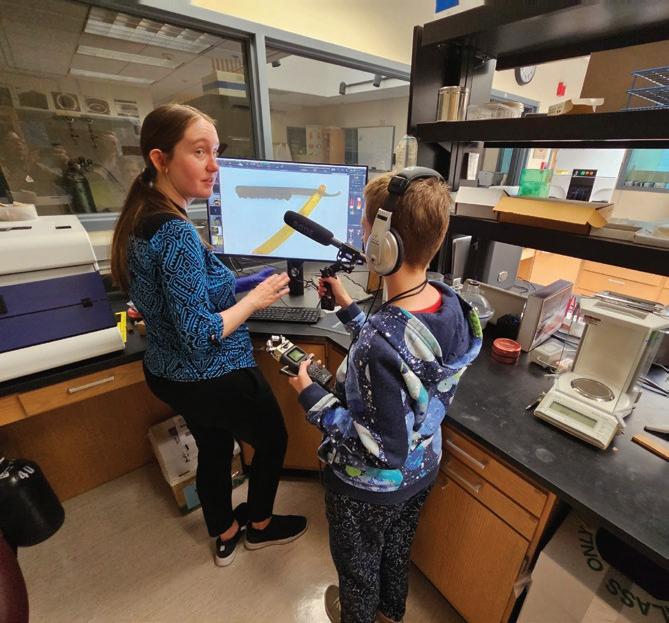
Support JPR Today
JPR relies on listener support as our primary source of funding. Support from new and returning donors enables us to continue broadcasting the programs you love. Basic membership begins at $45. You will receive 6 issues of the Jefferson Journal and you will also know you have done your part to help support public radio in the State of Jefferson.
Please fill out the form below and mail it to:
Jefferson Public Radio

Attn: Membership
1250 Siskiyou Blvd
Ashland, OR 97520
Contributions can also be made online at www.ijpr.org

Enclosed is my gift for $________.
The JPR services I enjoy are:
Classics & News Rhythm & News News & Information
Stay tuned for more information on the virtual and live events happening leading up to the October 11, 2023 anniversary of the Tragedy at Tunnel 13.
Chelsea Rose is an archaeologist with the Southern Oregon University Laboratory of Anthropology (SOULA) and host of Underground History, a monthly segment that airs during the Jefferson Exchange on JPR’s News & Information Service.
Forensic scientist Jen Tinsman runs a test to determine the razor’s material while Underground History producer Charlie Zimmermann documents the process
Name Organization Address City State / Zip Phone Email
TO EARTH
An Oregon Town Is Buying Surrounding Forests To Confront Wildfires
Editor’s Note: This story was originally published by Columbia Insight.
With a population of just 400 people, Butte Falls is a speck in an ocean of remote timberland, much of it burned.
The community is tucked into a vast forest of pine and fir about 35 miles from the California border. Outside town, snowcapped Mount McLoughlin towers above a vast burn scar, where blackened trees from the South Obenchain Fire stand crookedly across miles of the Cascade Range’s foothills.
In September 2020, logger Don Hamann watched as that blaze cast embers over his head in the middle of the night.
Hamann, 70, ignored an evacuation notice to protect his property and that of his neighbors on a woody rise above Butte Falls.
In the light of day, Hamann could see the smoke from a separate fire burning thousands of homes in nearby Ashland and Talent, and further to the north, yet another blaze leveled the mountain community of Blue River.
The Obenchain would burn 33,000 acres and skirted Butte Falls by just a quarter of a mile.
“You can’t stop it,” Hamann recalls. “It was amazing.”
Butte Falls residents disproportionately live with disabilities or in mobile homes, risk factors that make it difficult to prepare and evacuate from wildfires that have become increasingly destructive.
The hamlet itself, once a logging powerhouse, is still struggling to provide residents with good-paying jobs more than 40 years after the local timber industry began its long decline. Almost 10% of Butte Falls residents left town between 2010 and 2021.
Conventional wisdom in the region would have Butte Falls try to reclaim its former glory as a logging hub.
But community leaders have hatched an ambitious plan to protect their future by looking to the forest itself as a source of protection as much as prosperity.
The town government recently purchased a ring of privately owned timberland surrounding Butte Falls. Instead of harvesting the land—which could provide an immediate, shortterm boon to the town economy—locals want to grow an older and biodiverse forest that they say will better protect the town from wildfires, while attracting outdoor tourism.
Conservationists and the state’s top politicos say the small project playing out in a remote corner of Pacific Northwest forest can teach other communities how to adapt to climate disasters and hard times.
New vision
The 2018 blaze that killed at least 85 people in Paradise, Calif., was a wakeup call for Linda Spencer, who was the mayor of Butte Falls at the time.
At that point, Butte Falls was completely surrounded by about 400 acres of timberland that didn’t have much value for the community itself. Modern timber companies had rejected the practice of sustainable harvesting—low-intensity logging that provided a dependable supply of timber for future generations and, crucially, steady paychecks.
A string of companies since the 1980s intensively harvested parts of the land or let it grow wild, resulting in a dangerously dense and young forest on the community’s doorstep, a serious fire risk, according to Mike Smeltz, a veteran local forester.

Smeltz, Hamann and Spencer shared a new vision for the land. The logger, forester and former mayor believed that, if the town bought the forest, it could thin and burn unwanted foliage to cultivate open groves of old-growth trees resilient to wildfire and drought.
It’s a strategy some environmentalists want to implement across U.S. forests to sequester carbon, promote biodiversity and blunt severe wildfires—and one recently planned in Paradise itself as it rebuilds in California.
In the new Butte Falls Community Forest, local foresters could build a trail network and recreation amenities near a roaring waterfall to bring outdoor tourism to town, providing incomes without relying on dwindling timber jobs.
For Hamann, who has decades of experience in sustainable forestry projects, a beautiful forest is a more valuable asset in the long run than the timber from a clear cut, particularly if it’s your backyard.
Spencer, the former mayor, sees the project as a way for the community to assert control of a resource that is critical to the town’s future and the quality of its environment.
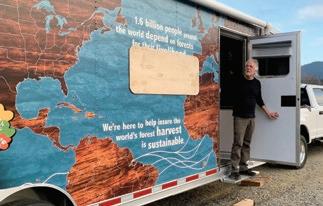
40 | JEFFERSON JOURNAL SEPTEMBER/OCTOBER 2023
A logger, forester and former mayor have joined forces to help Butte Falls protect its town and build an economy supported by tourism
GRANT
STRINGER DOWN
In September 2020, Don Hamann, 70 and a logger in Butte Falls, ignored an evacuation notice and stayed to protect his property from a wildfire.
AMANDA LOMAN/COLUMBIA INSIGHT
“The idea is, we didn’t want someone else managing the forest around us,” she says. “We wanted to manage it ourselves.”
When the Seattle-based timber giant Weyerhaeuser informed the Butte Falls City Hall of plans to clear-cut and sell the cleared parcels surrounding the town, likely to another timber company, Spencer jumped at the opportunity to create a community-owned forest instead.
The town purchased the 400-odd acres of woods last year for about $1.1 million with assistance from the Trust for Public Land, a conservation nonprofit. The cost was entirely covered by grants and donations, mostly from the Oregon state government and the U.S. Forest Service.
Hamann and several experts told Inside Climate News that Weyerhaeuser is dropping assets in much of southern Oregon because of climate-driven tree die-offs and wildfires, which would mark another notch in the industry’s decline.
A spokesperson for Weyerhaeuser declined to comment for this story.
New climate, new perspective
Destinies in Butte Falls were always linked to the forest.
The Butte Falls Sugar Pine Company built a sawmill and platted the town in 1906, according to historian Jeff LaLande. The firm took its name from the giant conifer of high cultural and religious value for the Achomawi people.
Loggers prized sugar pines for their smooth, straight timber.
In the 1980s, a Texas millionaire gutted the company that for decades had provided steady employment in Butte Falls. Almost all prized timber was cut and the mill sold, LaLande writes.
Smeltz, 68, moved to Butte Falls in the 1970s and watched the company’s liquidation plunge the town into a deep economic decline that it never truly recovered from, the forester said. It’s a familiar story across the Pacific Northwest.“ People didn’t have good jobs anymore,” he said. “When I came to town, the tavern was rockin’, alcohol was the drug of choice. Now, heroin is the drug of choice. Now it’s fentanyl.”
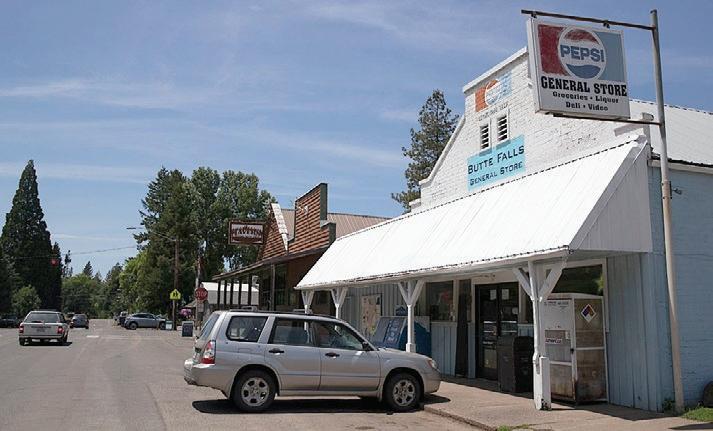
Smeltz embarked on a 40-year career in forestry, including 28 years with the U.S. Forest Service.
While Butte Falls changed, Smeltz watched the forests change around him. The climate in southern Oregon turned dry and hot, consistent with projections of human-caused climate change.
Firs in the region are dying en masse due to drought and insects, pock-marking the green forests of the Cascades with
brown sores that easily burn, Columbia Insight reported. Douglas firs, the state tree, which is high-value timber, are being replaced by species that are more resilient to drought.
Climate science is unpopular in Butte Falls, which is staunchly conservative, Smeltz says. But when a group of locals visited the new community forest on a recent Saturday, there was broad agreement that the climate is less hospitable for certain conifers than it once was.
Hamann had convened the meeting with a handful of residents as part of his weekly “forest chats,” where he describes his vision and seeks community buy-in over the roar of the falls.
On the warm afternoon, Hamann drew the group’s attention to a grove of century-old firs and pines. It’s the only mature forest remaining in the town-owned parcels and the first portion that would age enough to provide the biodiversity and wildfire resilience he envisions.
But much of the forest encircling Butte Falls is made up of young “ladder fuels,” a term in fire ecology for mid-sized foliage and low limbs that spread fire from the forest floor up to the canopy, where it is impossible to smother.
The town wouldn’t stand much of a chance if the forest around it burned in its current state, Stan Moore, another local retired from a career in forestry, told the others, who nodded grimly.
If Butte Falls can weather this fire season, Smeltz will lead efforts to thin the forest by cutting down young trees and deadlimbs, which will be piled and burned. That will help the largest trees, including mighty ponderosa pines towering above the thicket, to continue flourishing. The town already secured $450,000 from the Oregon Department of Forestry and another $450,000 from the Federal Emergency Management Agency for this work, according to Smeltz.
The community has partnered with Chris Adlam, an expert on prescribed burns with Oregon State University, to reintroduce low-intensity ground fires as often as once a year to mimic the natural fire cycle in the forest and further reduce the dangerous overload of woody fuels, he says.
Inside the town borders, Butte Falls is removing dangerous vegetation and ignition sources as part of the national Firewise USA network.
Mayor Trish Callahan said more work and education is planned to help prepare residents for the next wildfire.
‘The future of natural resources’
When he grew up in Cottage Grove, an Oregon community rocked by the so-called timber wars between loggers and environmentalists in the 1990s, Kelly Droege watched disagreements over land management turn nasty, pitting residents against each other.
Droege obtained a Master’s degree in forestry from the Yale School of the Environment and in 2018 founded Chinook Forest Partners, which manages 215,000 acres for timber companies in Oregon and Washington. The company’s portfolio briefly included the ring of forest surrounding Butte Falls.
He thinks deeply about the relationships rural communities have with forests and views Butte Falls as a case study in striking a balance between new and old ideas.
“This is the future of how we view management of natural resources,” says Droege.
SEPTEMBER/OCTOBER JEFFERSON JOURNAL | 41
Butte Falls, with 400 residents and near the California border, is shown on Saturday June 10, 2023.
AMANDA LOMAN/COLUMBIA INSIGHT
When she was in office, former Gov. Kate Brown, a Democrat, visited Butte Falls and designated it part of Oregon Solutions, a statewide policy network that fosters community-based solutions to thorny problems like high unemployment and wildfire danger. The state’s Democratic U.S. Sen. Jeff Merkley penned a letter expressing his support for the community forest and his staff have walked its stands of fir and pine, says Smeltz.
The project resonated in high places in part because of political acumen on the part of Spencer, the former mayor, who worked in the Environmental Protection Agency and the United Nations before retiring to Butte Falls.

Owen Wozniak, a program manager at the Land Trust Alliance, lauded Butte Falls’ work. But he said Spencer’s political connections and assistance from the Trust for Public Land make its example somewhat unusual.
“Most small communities just can’t access the resources and lack the financial and human capital to tackle such things,” he says. “There are thousands of communities across the West who need similar efforts. So it’s exemplary, but still too limited.”
Nonetheless, plans like those in Butte Falls are playing out across the region, from nearby Ashland, which has its own community-based model of fire adaptation, to Washington State as foresters and economic development experts push for new solutions in at-risk communities.
Nationally, there’s an excitement among conservationists and climate advocates that rural areas can leverage public lands to keep their communities functioning and safe from the most immediate hazards posed by the climate crisis. Towns have taken ownership of forests in Montana, Virginia and Vermont for a
range of purposes, including wildfire resilience, but Butte Falls’ approach is “pretty unique,” says Chris Dunn, an associate professor in Oregon State’s College of Forestry.
Butte Falls also benefits from the brain trust of Hamann, Smeltz, Moore and others who spent decades in forestry and logging.
And Dunn said it’s rare that a community can legally buy all the land immediately around it. Towns in fire country often abut public or tribal land or are constrained by an urban growth boundary, he said.
But Dunn said the work in Butte Falls to prevent homes from igniting, coupled with adequate management in the community forest, could offer significant protection to the town in future fire seasons.
After the community meeting, Hamann took a walking stick in each hand and traversed a section of the Obenchain Fire burn scar on a rise above town. Lupines and Indian paintbrush poked out of a dense understory that sprung up after the blaze. Above, massive sugar pines and incense cedars stood blackened as high as 50 feet up their trunks. But they were still alive.
“This stand right here survived about as tough a condition as you can possibly survive,” Hamann said.
His hope is that Butte Falls can become just as resilient.
Where There’s A Will There’s A Way! Our Gift To You...
JPR now offers a free online tool that enables you to create a legally valid will, completely free of cost.
This tool is for individuals who want to proactively manage their financial future, take care of loved ones, and have an opportunity to contribute to community organizations that reflect their lifelong values. The platform makes it easy to put your intentions and priorities on paper... and all it takes is about 20 minutes of your time (and no obligation to contribute to JPR).
Go to iJPR.org/make-a-bequest to learn more, and get started today!
Grant Stringer is a freelance journalist in Oregon who writes for national newspapers like the Washington Post and outlets in the West, including the Capital Chronicle and the Oregonian/OregonLive. He specializes in features, solutions journalism and social policy stories.
RECORDINGS

DAVE JACKSON
Molly Tuttle Is In Charge. We’ll Be Fine.

In 2017, Molly Tuttle became the first woman to be named the International Bluegrass Musician’s Association guitar player of the year. She was given the title again in 2018. Her 2022 release Crooked Tree took home the Grammy for best bluegrass album, and she was nominated in the broad category of Best New Artist. She just released her fourth full-length album, City of Gold, with her band of equally talented players, Golden Highway.
Tuttle grew up in Northern California (she now lives in Nashville). She began playing in her father’s band—The Tuttles with AJ Lee - featuring vocalist and mandolin virtuoso AJ Lee and Molly’s brother Sullivan who is also a gifted guitarist (Sullivan Tuttle and AJ Lee continue to collaborate in AJ Lee and Blue Summit). She studied music at Berklee and has worked along the way with a “who’s who” of great players, recently appearing on albums by Bela Fleck, Old Crow Medicine Show, Billy Strings, and the latest by Tommy Emmanuel, singing and trading licks with the acoustic guitar great on the Townes Van Zandt song “White Freightliner Blues”.
Crooked Tree is comprised of songs written by Tuttle. The album featured guest appearances by Darol Anger, Jason Carter, Sierra Hull, Old Crow Medicine Show and Gillian Welch, among others. City of Gold features songs written by Tuttle and Ketch Secor of Old Crow Medicine Show, and arranged in-studio with Golden Highway (Kyle Tuttle—not related—on banjo, award winning fiddle-player Bronwyn Keith-Hynes, upright bassist Shelby Means, and Dominick Leslie of the band Hawktail on mandolin), with only a few guest musicians. Tuttle says she found kinship and creative trust after touring with Golden Highway and wanted to tap into it. Input from the rest of the band gives this record musical depth while highlighting the chops of some of the best players of this era.
City of Gold was co-produced by dobro master Jerry Douglas. The result is a (mostly) bluegrass record with tons of shredding, themes about the west coast, clever storytelling, heartfelt introspection, and politics.
The lead off track “El Dorado” paints a picture of gold rush era California with a cast of characters in an old prospecting town. She likens the fervor of “gold fever” in the 1800’s with her own desire to make music and trends like cryptocurrency that drive people to extreme measures.
On Crooked Tree, she touches on cannabis with the song “Dooley’s Farm”, which, like prohibition songs about bootleggers, talks about the driver of a new underground economy in the South - weed: “They used to grow tobacco, then they made moonshine / Now there’s something better in the back of the

barn, down on Dooley’s Farm.” The song “San Joaquin” talks about bringing “Humboldt green” to California’s Central Valley by hopping a train. In “Down Home Dispensary” she writes a clever, open letter to the legislators, especially those in the South and her new home state, Tennessee, encouraging them to join the trend and at least make marijuana legal medicinally.
Recently, Molly Tuttle and Golden Highway recorded a version of the Jefferson Airplane classic “White Rabbit”. In the video they wear Alice in Wonderland costumes, Molly as the Queen of Hearts and Keith-Hynes as Alice. They continue the Wonderland theme with the new song “Alice in the Bluegrass”. In it Alice has an epiphany after a glimpse of a culture different from her own. Being from the San Francisco Bay Area, Tuttle seems well versed in Grateful Dead songs and plays a couple of them in her repertoire. “Alice in the Bluegrass” sounds like it could have also been inspired by a line in Scarlet Begonias, “Once in a while you get shown the light, in the strangest of places when you look at it right.”
On the surface, “Where Did All the Wild Things Go?” seems like a song about partying, but is meant as social commentary on gentrification, especially in Tuttle’s current home, Nashville. She explores relationships on a couple of tunes. “Yosemite” is a duet with Dave Matthews. It’s ironic among road trip songs, which tend to be about good times and new adventures. This one is about a road trip by a couple who incorrectly assume a vacation will rekindle their relationship. Instead, it’s a long uncomfortable car ride they both wish would end. “More Like a River” is a classic love song. It celebrates enduring love that rolls on and carries you, like a river as opposed to being marked by trinkets and flowers and temporary things.
Tuttle says that growing up, she was concerned about what might happen to women’s rights. “Goodbye Mary” takes on the topic of women’s reproductive freedom. It is a heartbreaking story of a pregnant woman in an abusive relationship who is unable to make her own decisions about what to do. It is based, in part, on a friend of Molly’s grandmother.
This is a well-deserved spotlight moment for Molly Tuttle. By all accounts, we expect it to last quite a while… Like enduring love… Like a river.
SEPTEMBER/OCTOBER JEFFERSON JOURNAL | 43
Music Director Dave Jackson hosts Open Air, weekdays on JPR’s Rhythm & News Service.
A Nature Notes Sampler II is a broad collection of radio com mentaries based on Dr. Frank Lang’s popular series that aired on JPR since the publication of the first volume in the year 2000. This collection of es says offers Dr. Lang’s same eclectic, often humorous view of the natural world in the mythical State of Jefferson and beyond.
Over 100 of Dr. Lang’s commentaries have been collected in this second vol ume. Make it your first collection of Nature Notes, or add it to the original publication for a complete set!
Order A Nature Notes Sampler II for $19.95 postpaid.

An eclectic blend of the best singer/songwriter, jazz, blues, world music and more, exploring the close connections between wildly different styles in an upbeat and spontaneous way.
Hosted by Danielle Kelly & Dave Jackson.

Weekdays 9am–3pm
JPR's Rhythm & News Service · www.ijpr.org

name phone address city state zip Make checks payable to: Jefferson Public Radio or bill to my credit card: VISA Mastercard American Express Discover card no exp amount: $19.95 Send completed form to: Nature Notes / Jefferson Public Radio, 1250 Siskiyou Blvd., Ashland, OR 97520
MILK STREET
CHRISTOPHER KIMBALL
No-Fry Neapolitan Eggplant Parmesan

At the family-owned trattoria La Tavernetta Vittozzi in Naples, Anna Vittozzi taught us to make a lighter, brighter eggplant Parmesan that still was rich with cheese and tangy with tomato sauce. The secret? Skip the breading. Though the Vittozzi version involved pan-frying eggplant, we found we could achieve similar results by roasting olive oilbrushed slices in the oven. This easier, more handsoffapproach yields golden-brown, silky-textured eggplant, perfect for layering with a simple tomato sauce and fresh basil, plus plenty of cheese. In addition to umami-packed Parmesan, the Vittozzis used smoked provolone, which added a delicious depth and savoriness to the dish. Smoked mozzarella might be easier to find in the U.S., and it’s a fine standin, as is scamorza cheese. If none of those are options, opt for low-moisture mozzarella cheese but avoid fresh mozzarella, which contains too much water.
TIP: Don’t peel offall of the skin from the eggplants. Remove the skin in interval strips so the eggplants looked striped. The skin helps hold the flesh together, so if all of it is peeled away, the eggplant slices too easily fall apart after cooking.
MAKES 6 TO 8 SERVINGS
1 3/4 HOUR, PLUS COOLING
Ingredients
7 tablespoons extra-virgin olive oil, divided 5 1-pound globe eggplants
Kosher salt and ground black pepper

1 medium yellow onion, finely chopped
1 28-ounce can crushed tomatoes
3 tablespoons salted butter, cut into 3 pieces
8 ounces smoked provolone, smoked mozzarella or smoked scamorza cheese, shredded(2 cups), divided 2 ounces parmesan cheese, finely grated (1 cup), divided 1 cup lightly packed fresh basil, torn
Directions
Heat the oven to 425°F with racks in the upper- and lowermiddle positions. Brush 2 rimmed baking sheets with 2 tablespoons oil each.
Remove half of the skin from each eggplant. To do this, using a vegetable peeler and working from top to bottom, peel offstrips of skin about 1 inch apart. Cut the eggplants crosswise into ¼-inch-thick rounds, then arrange in a single layer on the prepared baking sheets, slightly overlapping.
Brush the eggplant with 2 tablespoons of the remaining oil, then sprinkle lightly with salt and pepper. Roast until the slices are spottily browned, the edges are slightly crisped and the moisture has cooked off, 35 to 40 minutes; halfway through, use a wide metal spatula to flip the slices, then switch the positions of the baking sheets. Remove from the oven; leave the oven on.
Meanwhile, in a large saucepan over medium-low, heat the remaining 1 tablespoon oil until shimmering. Add the onion and ½ teaspoon salt; cover and cook, stirring occasionally, until the onion is translucent, 4 to 5 minutes. Stir in the tomatoes, butter, ½ teaspoon pepper and ½ cup water. Bring to a simmer, then reduce to medium-low and cook, stirring occasionally, until the sauce is slightly thickened, 15 to 20 minutes. Remove from the heat and cool for 15 minutes. Taste and season with salt and pepper. Measure 1 cup of the tomato sauce into a 9-by-13-inch baking dish and spread to cover the bottom. Arrange one-third of the eggplant on top of the tomato sauce, overlapping the slices if needed, then sprinkle evenly with 1 cup provolone, ¼ cup Parmesan and about half of the basil. Spoon on another ¾ cup tomato sauce and spread evenly. Layer on half of the remaining eggplant, followed by the remaining provolone, ¼ cup of the remaining Parmesan and the remaining basil. Spoon on another ¾ cup sauce and layer on the remaining eggplant. Cover with the remaining sauce, spreading it evenly, then sprinkle with the remaining Parmesan.
Bake on the lower rack until the edges are bubbling and the cheese is melted, 15 to 20 minutes. Cool for about 10 minutes before serving.
SEPTEMBER/OCTOBER JEFFERSON JOURNAL | 45
Christopher Kimball’s Milk Street in downtown Boston—at 177 Milk Street—is home to the editorial offices and cooking school. It also is where they record Christopher Kimball’s Milk Street television and radio shows. Milk Street is changing how we cook by searching the world for bold, simple recipes and techniques. For more information, go to177milkstreet.com. You can hear Milk Street Radio Sundays at 3:00pm on JPR’s News & Information service.
My Father Worries War is Coming
I tell him I’m dating a man and he says if I’m so lonely he’d drive across the country to live with me.
He reminds me I am his only son. He is one of seven and half his family died in the war. We found his sister’s photo in a temple and the monk wouldn’t let us take it with us. My dad never said he regretted leaving her again, but as his son, I should have made a home for her in my pocket. Would she be lonely next to photos of my dad at my age? The men I’ve loved have never seen those pictures. One man said he wished he knew me better. What is loneliness? Perfectly strained tea. Briefly waking with sunlight. I feel it must be quiet. Besides himself, my father has never seen a photo of me with a man I love. What is loneliness?
Sometimes I think I’m sad simply because I acknowledge the world. I’m so grateful. Am I lying if I never say this aloud?
The First X-Ray
Wilhem Roentgen aimed radiation at his test subjects, each holding photons like a dam holds flood. What spilled over was cast on film, a portrait
of what was lost: a metal sheet, a set of weights, his wife’s hand—silhouette of her wedding ring. The history of innovation cycles, a stone wheel
that hones a knife’s edge. Biotech is built small for warzones, to trace poison in water. Mustard gas fathered chemo: autopsies of blistered victims
showed tumors lulled into slumber. Wildfires clear stagnant fields nude and eventually you hardly remember the earth’s scarred flesh. Still,
I remember cadavers and my reluctant scalpel baring down onto bone. I remember someone said, They wanted you to learn, as if permission
could supplant the image of skin peeled out like an onion. Roentgen saw this muddled future; he called them X-rays, x for unknown,
but he predicted deformed fingers, twisted bowels, and hid behind lead. Even his wife, mother of lobar pneumonia, of excised bullets and clots, knew her role in this play. At her naked knuckles, she cried, I have seen my death, but not once did she pull her hand away.
Writers may submit original poetry for publication in Jefferson Journal
Email 3–6 poems, a brief bio, and your mailing address in one attachment to jeffmopoetry@gmail. com , or send 3–6 poems, a brief bio, and a selfaddressed, stamped envelope to:
Amy Miller, Poetry Editor Jefferson Journal
1250 Siskiyou Blvd Please allow eight Ashland, OR 97520 weeks for reply.
Eric Tran is a queer Vietnamese poet and the author of Mouth, Sugar, and Smoke, winner of the 2023 Oregon Book Award and finalist for the Thom Gunn Award, and The Gutter Spread Guide to Prayer. His poetry has been featured in All Things Considered, Poetry Daily, and Verse Daily, and has received recognition from Best of the Net, Prairie Schooner, and New Delta Review, among other publications. He is completing his fellowship in Addiction Psychiatry at the Oregon Health & Science University in Portland, Oregon.
46 | JEFFERSON JOURNAL SEPTEMBER/OCTOBER 2023
POETRY
ERIC TRAN
Cutting-edge illusionists perform sleight-of-hand, perplexing interactive mind magic, hilarious comedy, dangerous escapes and large scale illusions.

















TOMMY EMMANUEL THE TEMPTATIONS YESTERDAY AND TODAY: THE INTERACTIVE BEATLES EXPERIENCE sept 21 sept 19 sept 9 oct 6 KEB’ MO’ nov 8 Nov 5 Ian Bagg TOMÁSEEN FOLEY’S A CELTIC CHRISTMAS dec 20 opening nov 24 showing for two weekends SNEAK PEAK OF OUR WINTER–SPRING SEASON oct 7 REDDING’S HISTORIC cascadetheatre.org 530-243-8877 2023 SUMMER–AUTUMN SEASON
Southern Oregon University
1250 Siskiyou Blvd.
Ashland OR 97520-5025










 The U.S. government eventually issued 2,265,000 wanted posters printed in English and five other languages which were then distributed internationally. previous page: Tunnel 13, Ashland, Oregon—site of the last “great” train robbery in the west.
The blast set by the DeAutremont brothers ripped open the mail car, killing mail clerk Elvyn Daugherty of Ashland.
The U.S. government eventually issued 2,265,000 wanted posters printed in English and five other languages which were then distributed internationally. previous page: Tunnel 13, Ashland, Oregon—site of the last “great” train robbery in the west.
The blast set by the DeAutremont brothers ripped open the mail car, killing mail clerk Elvyn Daugherty of Ashland.








 by Juliet Grable and Erik Neumann
by Juliet Grable and Erik Neumann





















































































 Presenting world-class ensembles in the Southern Oregon University Music Recital Hall in Ashland, Oregon.
Presenting world-class ensembles in the Southern Oregon University Music Recital Hall in Ashland, Oregon.














































